
Arles • Avignon • Pont du Gard • Les Baux • St-Rémy-de-Provence • Orange • Côtes du Rhône Villages • Hill Towns of the Luberon
Map: Public Transportation in Provence
Map: Arles Hotels & Restaurants
Map: Avignon Hotels & Restaurants
Sleeping and Eating in Les Baux
Orientation to St-Rémy-de-Provence
Sleeping in St-Rémy-de-Provence
Orientation to Vaison-la-Romaine
Côtes du Rhône Wine Road Drive
Map: Côtes du Rhône Driving Tour
Sleeping in and near Isle-sur-la-Sorgue
Sleeping in and near Roussillon
The magnificent region of Provence is shaped like a giant wedge of quiche. From its sunburned crust, fanning out along the Mediterranean coast from the Camargue to Marseille, it stretches north along the Rhône Valley to Orange. The Romans were here in force and left many ruins—some of the best anywhere (the region’s name comes from its status as the first Roman province). Seven popes, artists such as Vincent van Gogh and Paul Cézanne, and author Peter Mayle all enjoyed their years in Provence. This destination features a splendid recipe of arid climate, oceans of vineyards, dramatic scenery, lively cities, and adorable hill-capping villages.
Explore the ghost town that is ancient Les Baux, and see France’s greatest Roman ruins—the Pont du Gard aqueduct and the theater in Orange. Admire the skill of ball-tossing boules players in small squares in every Provençal village and city. Spend a few Van Gogh-inspired starry, starry nights in Arles or St-Rémy-de-Provence. Youthful but classy Avignon bustles in the shadow of its brooding Palace of the Popes. It’s a short hop from Arles or Avignon into the splendid scenery and villages of the Côtes du Rhône and Luberon regions.
Make Arles or Avignon your sightseeing base—particularly without a car. Italophiles prefer smaller Arles, while poodles pick urban Avignon. Arles has a blue-collar quality; the entire city feels like Van Gogh’s bedroom. Avignon—double the size of Arles—feels sophisticated, with more nightlife and shopping, and makes a good base for nondrivers thanks to its convenient public-transit options. For drivers who prefer a smaller-town base, St-Rémy-de-Provence is well situated. To measure the pulse of rural Provence, spend at least one night in a village (such as Vaison-la-Romaine or Roussillon) or in the countryside. These villages can be terminally quiet from mid-October to Easter.

When budgeting your time, plan a full day for sightseeing in Arles and Les Baux (for example, spend most of the day in Arles—best on Wed or Sat, when it’s market day—and visit Les Baux in the late afternoon or early evening); a half-day for Avignon; and a day or two for the villages and sights in the countryside.
Pont du Gard is a short hop west of Avignon and on the way to/from Languedoc-Roussillon for drivers. Les Baux works well by car from Avignon and better from Arles, and in high season by bus from Arles. The town of Orange ties in tidily with a trip to the Côtes du Rhône villages. The Côtes du Rhône is ideal for wine connoisseurs and an easy stop for those heading to or from the north, as is Vaison-la-Romaine. Isle-sur-la-Sorgue (the most accessible small town by train) is conveniently located between Avignon and the Luberon.
By Bus or Train: Public transit is good between cities and decent to some towns, but marginal at best to the smaller villages. Frequent trains link Avignon, Arles, and Nîmes (no more than an hour between each). Avignon has good train connections with Orange and adequate service to Isle-sur-la-Sorgue.
Buses connect many smaller towns, though service can be sporadic. From Arles you can catch a bus to Les Baux (high season only) and Stes-Maries-de-la-Mer (in the Camargue), or St-Rémy. From Avignon, you can bus to Pont du Gard, St-Rémy, Isle-sur-la-Sorgue (also by train), and to some Côtes du Rhône villages.
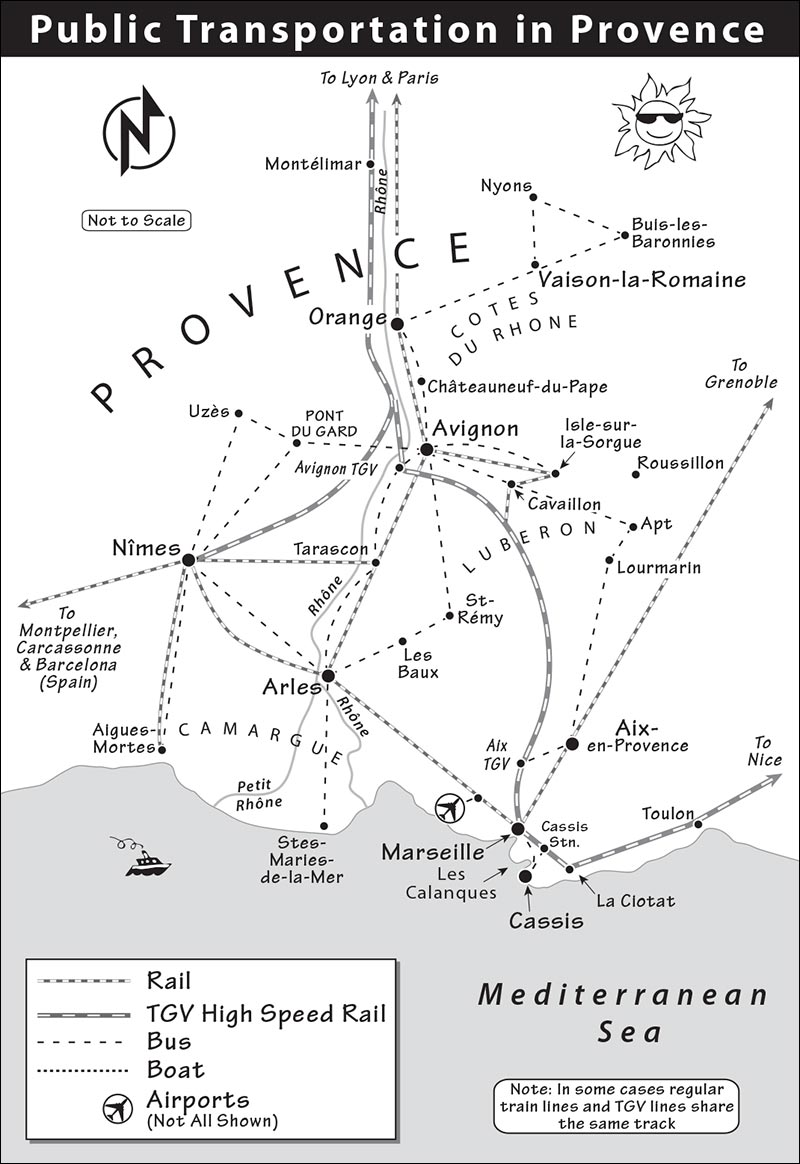
While a tour of the Côtes du Rhône or Luberon is best on your own by car, a variety of minivan tours and basic bus excursions are available. (TIs in Arles and Avignon also have information on bus excursions to regional sights that are hard to reach sans car; see “Tours in Provence.”)
By Car: The region is made for a car, though travel time between some sights will surprise you—thanks, in part, to narrow roads and endless roundabouts (for example, figure an hour from Les Baux to Pont du Gard, and almost two hours from Arles to Vaison-la-Romaine). Michelin map #527 (1:275,000 scale) covers this area perfectly. Michelin maps #332 (Luberon and Côtes du Rhône) and #340 (Arles area) are also worth considering. Be wary of thieves: Park only in well-monitored spaces and leave nothing valuable in your car. Drivers are smart to offload bags at hotels before sightseeing.
By Bike: Wind, heat, and hilly terrain make this region a challenge to bike. If you’re determined, I list bike rental options in most cities (including electric bikes). Telecycles will deliver your bike to hotels within about 12 miles of St-Rémy (tel. 04 90 92 83 15 or mobile 06 11 64 04 69, www.telecycles-location.com). Check also with Sun-e-Bike for handy electric bike rentals throughout Provence (www.location-velo-provence.com).
Dutchman Mike Rijken runs a one-man show, taking travelers through the region he adopted 25 years ago. His English is fluent, and though his focus is on wine and wine villages, Mike knows the region thoroughly and is a good teacher of its history (per person: €80/half-day, €140/day, 2-6-person groups; pickups possible in Arles, Avignon, Lyon, Marseille, or Aix-en-Provence; tel. 04 90 35 59 21, mobile 06 19 29 50 81, www.winesafari.net, mikeswinesafari@orange.fr).
Charming Céline Viany—a sommelier and easy-to-be-with tour guide—is an expert on her region and its chief product (from €200/half-day or €250/day for 2 people, price depends on pickup location and number of clients, tel. 04 90 46 90 80, mobile 06 76 59 56 30, www.levinalabouche.com, contact@degustation-levinalabouche.com).
For a playful perspective on wines of the Côtes du Rhône region, contact François Marcou (€110/person for all-day wine tours that include 4 tastings, €80/person for half-day tours, €350 for private groups, less in winter, mobile 06 28 05 33 84, www.avignon-wine-tour.com, contact@avignon-wine-tour.com).
Passionate Englishman Olivier Hickman takes small groups on focused tours of selected wineries in Châteauneuf-du-Pape and in the villages near Vaison-la-Romaine. Olivier knows his subject matter inside and out. His in-depth tastings include a half-day tour of two or three wineries (€40-75/person for half-day to full-day tours, prices subject to minimum tour fees, mobile 06 75 10 10 01, www.wine-uncovered.com, olivier.hickman@orange.fr).
Low-key American Doug Graves, who owns a small wine domaine in the Côtes du Rhône, runs custom tours of Châteauneuf-du-Pape, the villages of the Côtes du Rhône, and the Luberon Valley (per person: €135/day, up to 4 people, includes lunch; mobile 06 37 16 04 56, www.toursdurhone.com, doug@masdelalionne.com).
This company offers small group tours centered on wine and food with a good dose of history and local culture. Experienced guide and wine connoisseur Joe McLean leads walking and photography tours, as well as wine tours focusing on the wines of Uzès, Châteauneuf-du-Pape, and the Côtes du Rhône (per person: about €70-95/half-day, €140-170/day, prices include pickup from Uzès hotels; custom tours possible from Arles and Avignon, no tours on Sun, mobile 06 73 08 23 97, www.wineryplustours.com, contact@wineryplustours.com).
Sommelier Romain Gouvernet is a young and sincere wine guide concentrating on Châteauneuf-du-Pape and the Luberon. Ask about his evening wine tours (per person: €90/half-day, €140/day; mobile 06 86 49 56 76, www.provenceandwine.com, provenceandwine@gmail.com).
This organization offers personalized cultural excursions that highlight the “true heart of Provence and Occitania.” Itineraries are adapted to your interests, and your guide can meet you at your hotel or the departure point of your choice (€190/half-day, €315/day, prices for up to 4 people starting from near Avignon or Arles, mobile 06 89 22 19 87, www.imagine-tours.net, imagine.tours@gmail.com). They can also help plan your itinerary, book hotel rooms, or address other travel issues.
Catherine D’Antuono is a smart, capable, licensed guide for Aix-en-Provence and the region. She guides tours as far west as Pont du Gard and as far east as St-Tropez (€480/day for 2 people, €15 extra for each additional person, 8-person maximum, mobile 06 17 94 69 61, www.provence-travel.com, tour.designer@provence-travel.com).
Discover Provence was founded by England-born Sarah Pernet, who has lived in Aix-en-Provence since 2001. She and her small team offer a variety of well-organized, easygoing, small-group tours to the Luberon, Cassis, Arles, and St-Rémy (from €130/person for half-day, mobile 06 16 86 40 24, www.discover-provence.net, sarah@discover-provence.net).
This company runs day tours from Avignon, Arles, Marseille, Nice, and Aix-en-Provence. Tours provide introductory commentary, but no guiding at sights. They use eight-seat, air-conditioned minivans (per person: about €65-80/half-day, €100-125/day). Ask about their cheaper big-bus excursions, or consider hiring a van and driver for your private use (allow about €300/half-day, €500/day, tel. 04 90 14 70 00, www.provence-reservation.com).
Provence is littered with Roman ruins. Many scholars claim the best-preserved ancient Roman buildings are not in Italy, but in France. These ancient stones will be an important part of your sightseeing agenda in this region, so it’s worth learning about how they came to be.
Classical Rome endured from about 500 BC through AD 500—spending about 500 years growing, 200 years peaking, and 300 years declining. Julius Caesar conquered Gaul—which included Provence—during the Gallic Wars (58-51 BC), then crossed the Rubicon River in 49 BC to incite civil war within the Roman Republic. He erected a temple to Jupiter on the future site of Paris’ Notre-Dame Cathedral.
The concept of one-man rule lived on with his grandnephew, Octavian (whom he had also adopted as his son). Octavian killed Brutus, eliminated his rivals (Mark Antony and Cleopatra), and united Rome’s warring factions. He took the title “Augustus” and became the first in a line of emperors who would control Rome for the next 500 years—ruling like a king, with the backing of the army and the rubber-stamp approval of the Senate. Rome morphed from a Republic into an Empire: a collection of many diverse territories ruled by a single man.
Augustus’ reign marked the start of 200 years of peace, prosperity, and expansion known as the Pax Romana. At its peak (c. AD 117), the Roman Empire had 54 million people and stretched from Scotland in the north to Egypt in the south, as far west as Spain and as far east as modern-day Iraq. To the northeast, Rome was bounded by the Rhine and Danube Rivers. On Roman maps, the Mediterranean was labeled Mare Nostrum (“Our Sea”). At its peak, “Rome” didn’t just refer to the city, but to the entire civilized Western world.
The Romans were successful not only because they were good soldiers, but also because they were smart administrators and businessmen. People in conquered territories knew they had joined the winning team and that political stability would replace barbarian invasions. Trade thrived. Conquered peoples were welcomed into the fold of prosperity, linked by roads, education, common laws and gods, and the Latin language.
Provence, with its strategic location, benefited greatly from Rome’s global economy and grew to become an important part of its worldwide empire. After Julius Caesar conquered Gaul, Emperor Augustus set out to Romanize it, building and renovating cities in the image of Rome. Most cities had a theater (some had several), baths, and aqueducts; the most important cities had sports arenas. The Romans also erected an elaborate infrastructure of roads, post offices, schools (teaching in Latin), police stations, and water-supply systems.
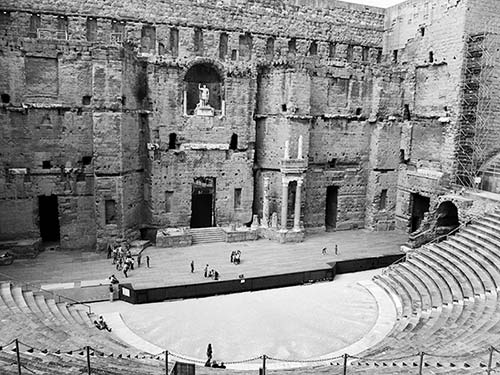
A typical Roman city (such as Nîmes, Arles, Orange, or Vaison-la-Romaine) was a garrison town, laid out on a grid plan with two main roads: one running north-south (the cardus), the other east-west (the decumanus). Approaching the city on your chariot, you’d pass by the cemetery, which was located outside of town for hygienic reasons. You’d enter the main gate and wheel past warehouses and apartment houses to the town square (forum). Facing the square were the most important temples, dedicated to the patron gods of the city. Nearby, you’d find bathhouses; like today’s fitness clubs, these served the almost sacred dedication to personal vigor. Also close by were businesses that catered to the citizens’ needs: the marketplace, bakeries, banks, and brothels.
Aqueducts brought fresh water for drinking, filling the baths, and delighting the citizens with bubbling fountains. Men flocked to the stadiums in Arles and Nîmes to bet on gladiator games; eager couples attended elaborate plays at theaters in Orange, Arles, and Vaison-la-Romaine. Marketplaces brimmed with exotic fruits, vegetables, and animals from the far reaches of the empire. Some cities in Provence were more urban 2,000 years ago than they are today. For instance, experts believe that Roman Arles had a population of between 70,000 and 100,000—almost double today’s size. Think about that when you visit.
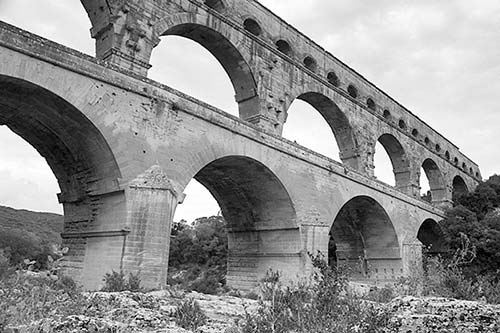
When it came to construction, the Romans eventually discovered a magic building ingredient: concrete. A mixture of volcanic ash, lime, water, and small rocks, concrete—easier to work than stone and longer-lasting than wood—served as flooring, roofing, filler, glue, and support. Builders would start with a foundation of brick, then fill it in with poured concrete. They would then cover important structures, such as basilicas, in sheets of expensive marble (held on with nails), or decorate floors and walls with mosaics—proving just how talented the Romans were at turning the functional into art.
The almost extravagant use (by French standards) of garlic, olive oil, herbs, and tomatoes makes Provence’s cuisine France’s liveliest. To sample it, order anything à la provençale. Among the area’s spicy specialties are ratatouille (a mixture of vegetables in a thick, herb-flavored tomato sauce), aioli (a rich, garlicky mayonnaise spread over vegetables, potatoes, fish, or whatever), tapenade (a paste of pureed olives, capers, anchovies, herbs, and sometimes tuna), soupe au pistou (thin yet flavorful vegetable soup with a sauce—called pistou—of basil, garlic, and cheese), and soupe à l’ail (garlic soup, called aigo bouido in the local dialect). Look for riz de Camargue (the reddish, chewy, nutty-tasting rice that has taken over the Camargue area) and taureau (bull’s meat). The native goat cheeses are banon de banon or banon à la feuille (dipped in brandy and wrapped in chestnut leaves) and spicy picodon. Don’t miss the region’s prized Cavaillon melons (cantaloupes) or its delicious cherries and apricots, which are often turned into jams and candied fruits.
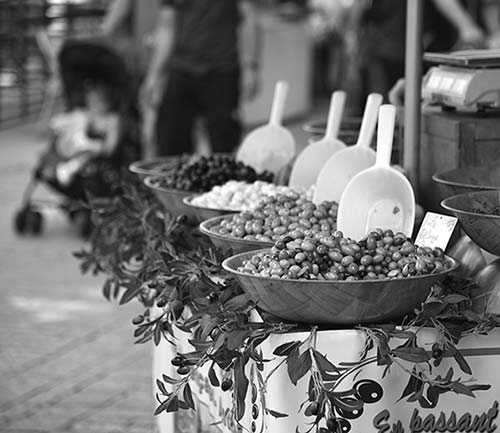
Wines of Provence: Provence also produces some of France’s great wines at relatively reasonable prices (€5-10/bottle on average). Look for wines from Gigondas, Rasteau, Cairanne, Beaumes-de-Venise, Vacqueyras, and Châteauneuf-du-Pape. For the cheapest but still tasty wines, look for labels showing Côtes du Rhône Villages or Côtes de Provence. If you like rosé, you win. Rosés from Tavel are considered among the best in Provence. For reds, splurge for Châteauneuf-du-Pape or Gigondas, and for a fine aperitif wine or a dessert wine, try the Muscat from Beaumes-de-Venise.
Provençal market days offer France’s most colorful and tantalizing outdoor shopping. The best markets are on Monday in Cavaillon, Tuesday in Vaison-la-Romaine, Wednesday in St-Rémy, Thursday in Nyons or Orange, Friday in Lourmarin and Bonnieux, Saturday in Arles, Uzès, and Apt, and, best of all, Sunday in Isle-sur-la-Sorgue. Crowds and parking problems abound at these popular events—arrive by 9:00, or, even better, sleep in the town the night before.
Arles (pronounced “arl”) is an amiable slice of Provence, with evocative Roman ruins, an eclectic assortment of museums, made-for-ice-cream pedestrian zones, and squares that play hide-and-seek with visitors.
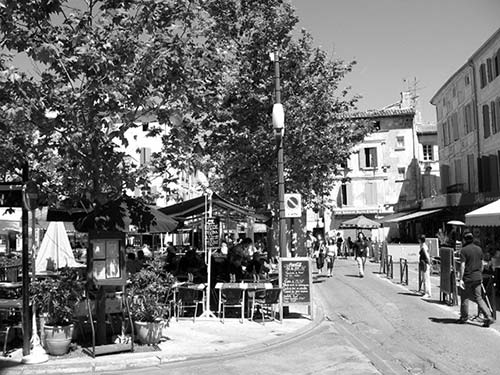
Back in Roman times, the city earned the imperial nod by helping Julius Caesar defeat his archrival Pompey at Marseille, and grew into an important port. Site of the first bridge over the Rhône River, Arles was a key stop on the Roman road from Italy to Spain, the Via Domitia. After reigning as the seat of an important archbishop and as a trading center for centuries, the city became a sleepy afterthought of little importance in the 1700s. Vincent van Gogh settled here in the late 1800s, but left only a chunk of his ear. American bombers destroyed much of Arles in World War II as the townsfolk hid out in its underground Roman galleries.
Today Arles, while touristic, feels like a backwater. A city in search of an economy, workaday Arles feels unpolished and even a little dirty compared to nearby Avignon and Nîmes. But to me, that’s part of its charm. Locals display a genuine joie de vivre that’s hard to sense in Arles’ larger, more cosmopolitan neighbors.
For a helpful overview to your Arles sightseeing, start at the Ancient History Museum. Drivers should try to do this museum on their way into Arles—then head to the city-center sights, linked by my Arles City Walk. For cost-efficient sightseeing, get one of the city’s sightseeing passes, which cover the ancient monuments and the Ancient History Museum.
Arles faces the Mediterranean, turning its back on Paris. And although the town is built along the Rhône, it largely ignores the river. Landmarks hide in Arles’ medieval tangle of narrow, winding streets. Hotels have good, free city maps, and helpful street-corner signs point you toward sights and hotels.
The TI is on the ring road Boulevard des Lices, at Esplanade Charles de Gaulle (daily 9:00-18:45; Oct-March Mon-Sat 9:00-16:45, Sun 10:00-13:00; tel. 04 90 18 41 20, www.arlestourisme.com). Ask about walking tours and “bullgames” in Arles and nearby towns (Provence’s more humane version of bullfights—see “Experiences in Arles,” later). The TI sells worthwhile city sightseeing passes (see “Helpful Hints,” later).
By Train or Bus: The train station is on the river, a 10-minute walk from the town center. There are two good options for baggage storage (see “Helpful Hints,” later). The main bus station is on big Boulevard Georges Clemenceau, but some buses stop at the train station.
To reach the town center or Ancient History Museum from the train station without walking, wait for the free Navia shuttle at the glass shelter facing away from the station (cross the street and veer left, 2/hour Mon-Sat 7:00-19:00, none Sun). The bus makes a counterclockwise loop around Arles, stopping near most of my recommended hotels (see “Arles” map for stops). Taxis usually wait in front of the station (if there’s not a taxi waiting, call 04 90 96 52 76 or the posted telephone numbers, or ask the info desk staff to call for you). Though the rides are short, allow €12 to any of my recommended hotels.
By Car: I’d avoid driving in old Arles. Enter on foot after stowing your car (at least temporarily) at Arles’ only parking garage, Parking des Lices, near the TI on Boulevard des Lices (about €2/hour, €18/24 hours). All of my recommended hotels are within a 10-minute walk of this garage. Most hotels have parking deals for a nearby lot (ask before you arrive).
Lots and curbside parking spots in Arles center are metered 9:00-19:00 every day May-Sept (some limited to 2.5 hours). You’ll find metered lots along the city wall at Place Lamartine (except Tue night, when it is restricted). To find these, first follow signs to Centre-Ville, then Gare SNCF (train station) until you come to the roundabout with a Monoprix department store to the right. The hotels I list are no more than a 15-minute walk from here.
Sightseeing Tips: Arles has a smart ticket-and-hours plan for its sightseeing. Ancient monuments, such as the Roman Arena and Classical Theater, share the same hours (daily 9:00-19:00, April and Oct until 18:00, Nov-March 10:00-17:00).
A €9 entry fee gets you access to all of Arles’ monuments (but not its museums). The good-value Pass Liberté (€12) covers any four monuments and one museum of your choice (I recommend the Ancient History Museum). The Pass Avantage (€16) covers all monuments and museums and is worthwhile if you plan to visit two or more museums. Both passes offer a discount at the Fondation Van Gogh. Buy your pass at the TI or any included sight.
Van Gogh Trail: The TI has placed various “Van Gogh easels” around town marking points where Vincent set up his easel and painted. Many (but not all) are incorporated into my “Arles City Walk.”
Market Days: The big markets are on Wednesdays and Saturdays.
Crowds: An international photo event jams hotels the second weekend of July. The let-’er-rip, twice-yearly Féria draws crowds over Easter and in mid-September.
Baggage Storage and Bike Rental: Taco & Co stores luggage and rents bikes; it’s located by the bus stop across from the train station (€5/bag, bike rental €7/half-day, €10/day, Mon-Sat 9:00-18:00, closed Sun, tel. 04 82 75 73 45, www.tacoandco.fr). The recommended Hôtel Régence will store your bags (€3/bag, daily 7:30-22:00, closed in winter, 5 Rue Marius Jouveau). They also rent bikes (€7/half-day, €15/day, one-way rentals within Provence possible, same hours as baggage storage). From Arles you can ride to Les Baux (25 miles round-trip)—but it’s a darn steep climb. Those in great shape can consider biking into the Camargue (level 30-40-mile round-trip, forget it on windy days).
Laundry: A launderette is at 41 Rue du 4 Septembre. Another is near the bus station at 34 Boulevard Georges Clemenceau. Both are open long hours daily.
Car Rental: Europcar and Hertz are downtown (Europcar is at 61 Avenue de Stalingrad, tel. 04 90 93 23 24; Hertz is closer to Place Voltaire at 10 Boulevard Emile Combes, tel. 04 90 96 75 23).
Local Guides: Charming Agnes Barrier knows Arles and nearby sights intimately. Her tours cover Van Gogh and Roman history (€145/3 hours, mobile 06 11 23 03 73, agnes.barrier@hotmail.fr). Alice Vallat offers scheduled visits of Arles’ key sights that leave from the TI, usually at 16:00 several days a week (€25/person for 1.5-hour group tour, €145 for 3-hour private tour, mobile 06 74 01 22 54, www.guidearles.com, alice.vallat13@gmail.com). Ask about her city tours that add wine tasting.
Public Pools: Arles has three pools (indoor and outdoor). Ask at the TI or your hotel for hours and locations.
In this flat city, everything’s within walking distance. Only the Ancient History Museum is far enough out to consider a shuttle or taxi ride. The riverside promenade provides a scenic and direct stroll to the Ancient History Museum (as well as to the train station).
The free Navia shuttle circles the town, stopping at the train station and along Rue du 4 Septembre, then along the river. It’s useful for access to my recommended hotels and the Ancient History Museum (see “Arles” map for stop locations, 2/hour, Mon-Sat 7:00-19:00, none Sun).
2 Starry Night over the Rhône Easel
4 Old Town
8 L’Entrée du Jardin Public Easel
9 Classical Theater (Théâtre Antique)
10 Republic Square (Place de la République)
11 Cryptoporticos (Cryptoportiques)
18 Forum Square (Place du Forum) and Café Terrace at Night Easel
The joy of Arles is how its compact core mixes ancient sights, Van Gogh memories, and a raw and real contemporary scene that is easily covered on foot. All dimensions of the city come together in this self-guided walk.
Length of This Walk: If you enter the sights described (which I recommend, even if briefly), this walk will take most of a day. If the walk seems long, you could split it up and do the latter half in the evening.
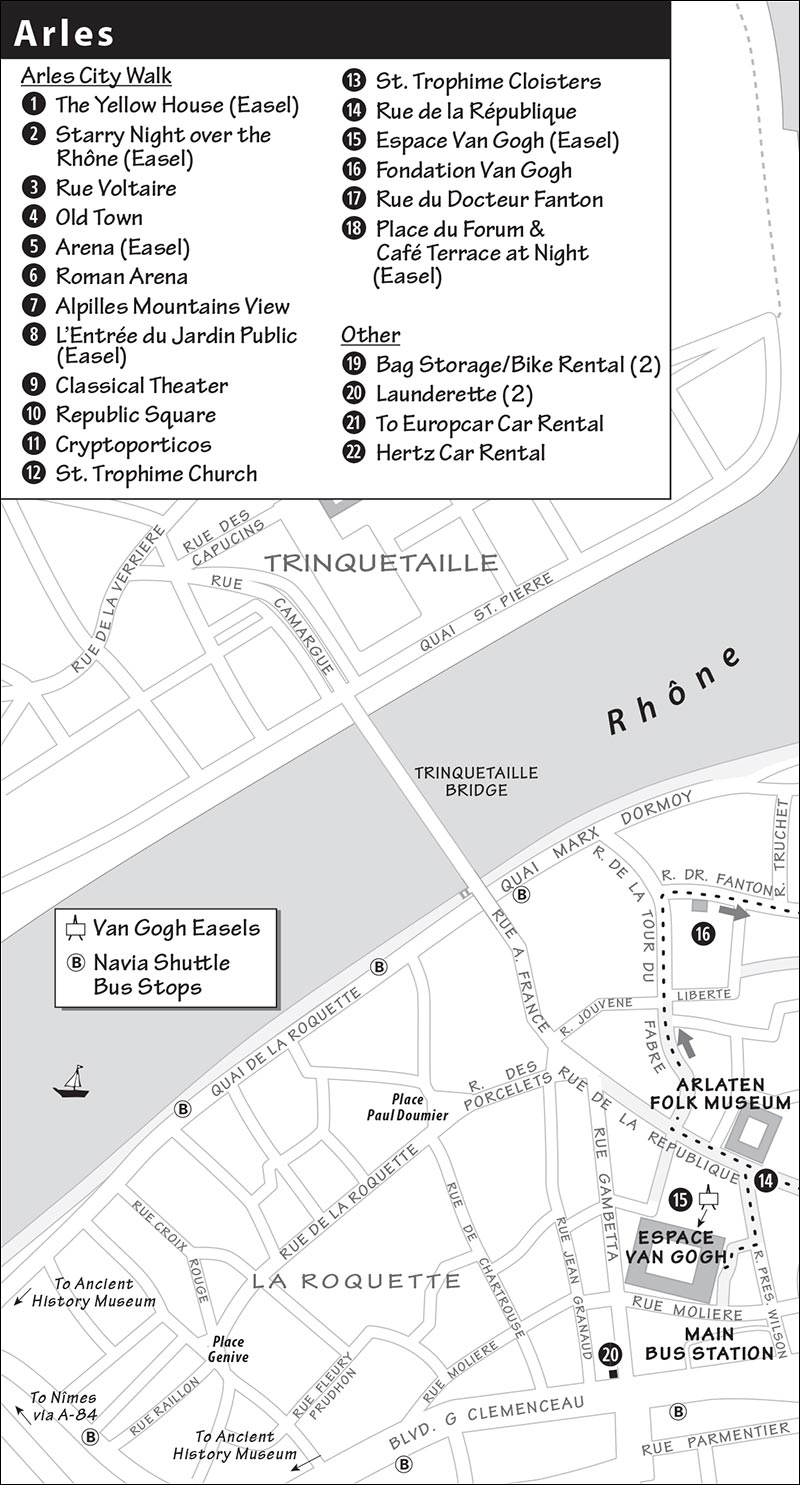
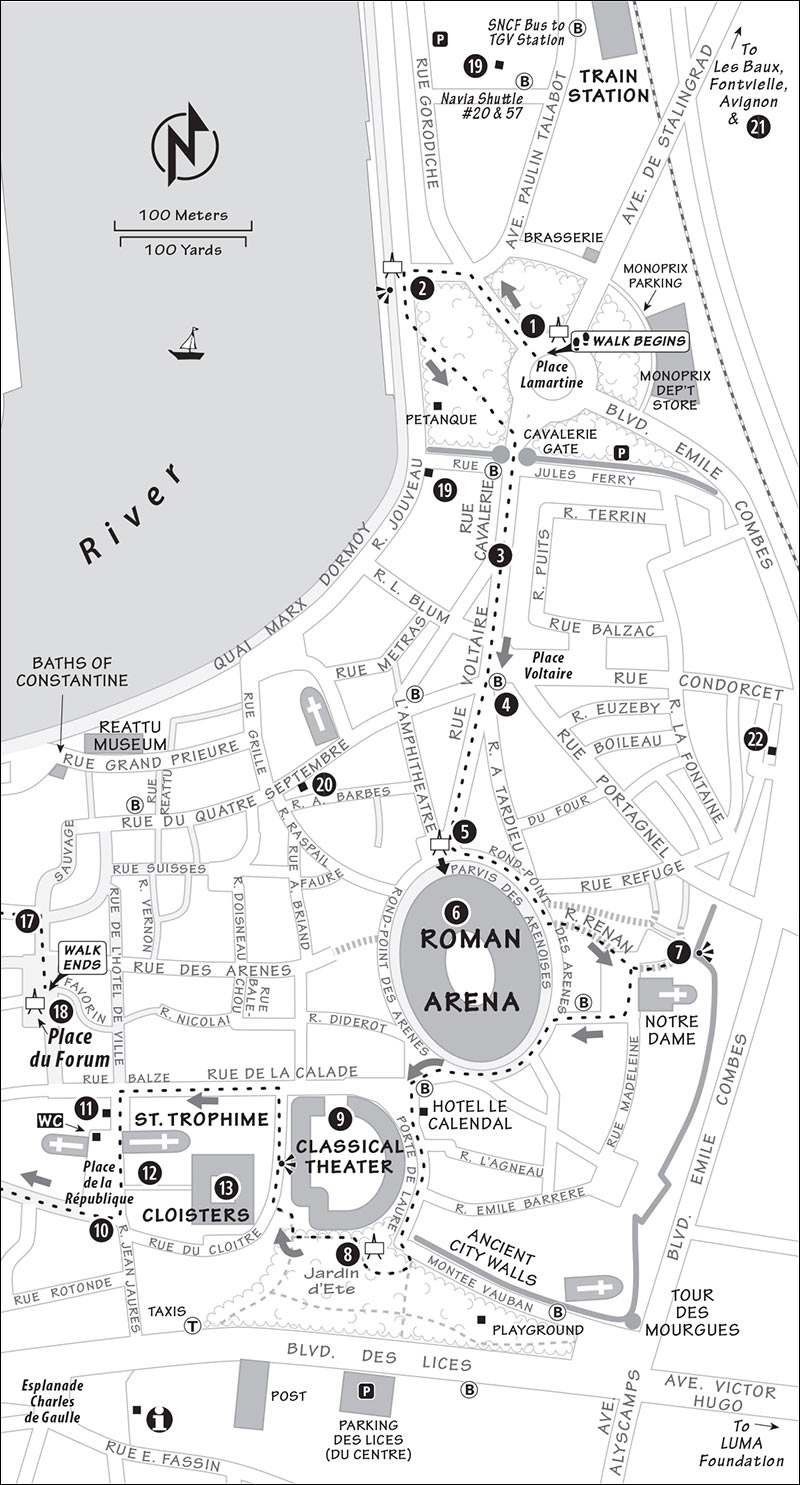
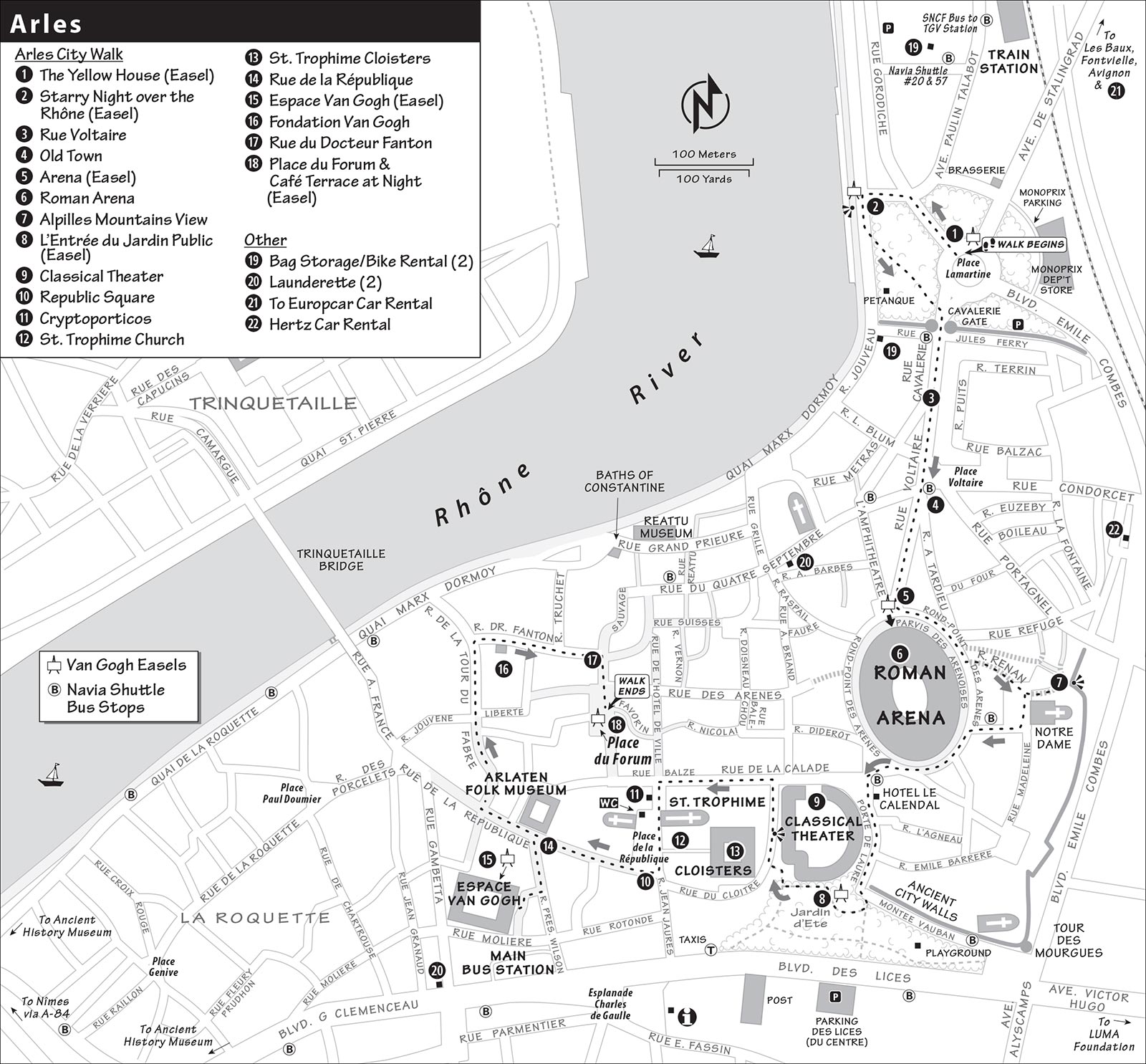
Tours: To trace the route of this walk, see the “Arles” map, earlier.  Download my free Arles City Walk audio tour (available in 2019), and you can put this book away and join me for a delightful, historic stroll through Arles.
Download my free Arles City Walk audio tour (available in 2019), and you can put this book away and join me for a delightful, historic stroll through Arles.
Sightseeing Tips: Most sights on this walk are covered by the city’s sightseeing passes—sold at the TI and included sights (see “Helpful Hints,” earlier). I’ve also listed the full prices for sights, if you’re not using a sightseeing pass. To better understand the ancient sites along this route, visit the Ancient History Museum before taking this walk (see “Sights in Arles,” later).
The life and artistic times of Dutch artist Vincent van Gogh form a big part of Arles’ draw, and the city does a fine job of highlighting its Van Gogh connection with its Van Gogh Trail: Throughout town, about a dozen steel-and-concrete panels, or “easels,” provide then-and-now comparisons, depicting the artist’s paintings alongside the current view of that painting’s subject.
In the dead of winter in 1888, 35-year-old Van Gogh left big-city Paris for Provence, hoping to jump-start his floundering career and social life. He was as inspired as he was lonely. Coming from the gray skies and flat lands of the north, Vincent was bowled over by everything Provençal—the sun, bright colors, rugged landscape, and raw people. For the next two years he painted furiously, cranking out a masterpiece every few days.
Of the 200-plus paintings that Van Gogh made in the south, none permanently resides in the city that so moved him. (But there is always at least one here on loan, displayed at the Fondation Van Gogh gallery, which we’ll visit on this stroll). But walking the same streets he knew and seeing the places he painted, you can understand how Arles inspired him.
 SELF-GUIDED WALK
SELF-GUIDED WALK• Start at the north gate of the city, just outside the medieval wall on Place Lamartine (100 yards in front of the medieval gate, with the big Monoprix store across the street to the right, beyond the roundabout). A four-foot-tall easel shows Van Gogh’s painting.
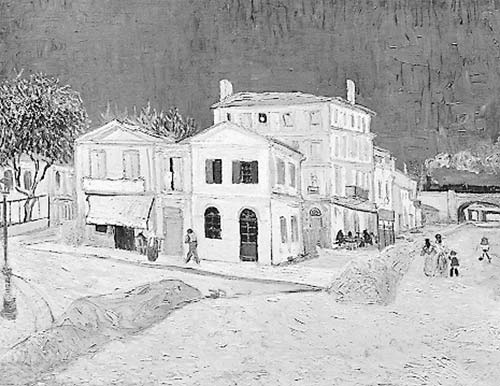
Vincent arrived in Arles on February 20, 1888, to a foot of snow. He rented a small house here on the north side of Place Lamartine. The house was destroyed in 1944 by an errant bridge-seeking bomb, but the four-story building behind it still stands (find it in the painting). The house (which stood where the street runs today) had four rooms, including a small studio and the cramped trapezoid-shaped bedroom made famous in his paintings. It was painted yellow inside and out, and Vincent named it...“The Yellow House.” In the distance, the painting shows the same bridges you see today.
In those days, a short walk from Place Lamartine led to open fields. Donning his straw hat, Vincent set up his easel outdoors and painted quickly, capturing what he saw and felt—the blossoming fruit trees, gnarled olive trees, peasants sowing and reaping, jagged peaks, and windblown fields, all lit by a brilliant sun that drove him to use ever-brighter paints.
• Walk to the river.

As you walk, you’ll pass: on the right, an eight-foot-tall stone monument in honor of two WWII American pilots killed in action during the liberation of Arles (erected in 2002 as a post-9/11 sign of solidarity with Americans); a post celebrating Arles’ nine sister cities (left); and a big concrete high school and tour bus parking lot (right).
At the river, find the easel in the wall where ramps lead down. The Roman bridge stood here (look for a few stones directly across), and just upstream are the remains of a modern bridge bombed by the Allies in World War II.
• Now, turn your attention to the...
One night, Vincent set up his easel along the river and painted the stars boiling above the city skyline. Vincent looked to the night sky for the divine and was the first to paint outside after dark, adapting his straw hat to hold candles (which must have blown the minds of locals back then). As his paintings progressed, the stars became larger and more animated (like Vincent himself). The lone couple in the painting pops up again and again in his work. (Note: This painting is not the Starry Night you’re probably thinking of—that one was painted later, in St-Rémy.)
• With your back to the river, angle right through the scruffy park of plane trees (a kind of sycamore). Continue into town through the park and between the stumpy 14th-century stone towers where the city gates once stood. Walk a block up Rue de la Cavalerie to the decorative (if dry) fountain with the colorful old mosaic.
Van Gogh first walked into town down this street in 1888. When he saw this fountain, it was just a year old. Its mosaic celebrates the high culture of Provence (she’s the winged woman who obviously loves music and reading). But this neighborhood was Arles’ 19th-century red light district, and the far-from-home Dutchman spent many lonely nights in its bars and brothels. Though it’s no longer the rough area it was in Van Gogh’s day, this street still has a certain edgy local color with humble shops, bars, and bakeries.
• Stay left and keep walking to Place Voltaire, a center of this working-class neighborhood (the local Communist Party headquarters is across the square on the left). Stop at the top end of the square under the plane tree in front of Brasserie le Pitchounet.
Take a slow 360-degree spin tour to just enjoy the rough elegance of the architecture. Pretend you’re a one-eared painter looking for a place to set up your easel. You’ve left the bombed-out part of town and entered the old town, with buildings predating World War II. The stony white arches of the ancient Roman Arena ahead mark your destination. As you hike up Rue Voltaire, notice the shutters, which contribute to Arles’ character. The old town is strictly protected: These traditional shutters come in a variety of styles but cannot be changed.
• Keep straight up Rue Voltaire, climb to the Roman Arena, and find the Arena easel at the top of the stairs, to the right.
All summer long, fueled by sun and alcohol, Vincent painted the town. He loved the bullfights in the arena and sketched the colorful surge of the crowds, spending more time studying the people than watching the bullfights (notice how the bull is barely visible). Vincent had little interest in Arles’ antiquity—it was people and nature that fascinated him.
• At this point you can take a break from your town walk and visit the Roman Arena or read about it as you circle clockwise to the left.
This well-preserved arena is worth ▲▲ and is still in use today. Nearly 2,000 years ago, gladiators fought wild animals to the delight of 20,000 screaming fans. Now local daredevils still fight wild animals here—“bullgame” posters around the arena advertise upcoming spectacles (see “Experiences in Arles,” later). Don’t miss the tower climb for fantastic views over Arles, the arena, and the Rhône River.
Cost and Hours: €9 combo-ticket with Classical Theater; daily 9:00-19:00, April and Oct until 18:00, Nov-March 10:00-17:00, Rond-point des Arènes, tel. 04 90 49 36 86, www.arenes-arles.com.
Visiting the Arena: After passing the ticket kiosk, find the helpful English display under the second arch, where you can read about the arena’s history and renovation. Then climb up and take a seat in the theater.
Thirty-four rows of stone bleachers extended all the way to the top of those vacant arches that circle the arena. All arches were numbered to help distracted fans find their seats. The many passageways you’ll see (called vomitoires) allowed for rapid dispersal after the games—fights would break out among frenzied fans if they couldn’t leave quickly.
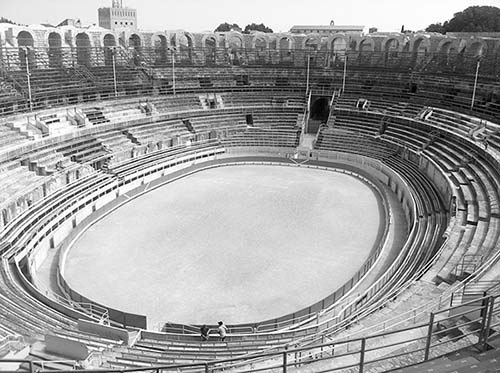
The arena takes its name from the central floor where the action took place—“arena” derives from the Latin word for sand, which was spread across the floor to absorb the blood. Wild animals were caged in passages and storage areas underneath the floor and hoisted up on an elevator to make surprise appearances. (While Rome could afford exotic beasts, places like Arles made do with snarling local fauna...bulls, bears, and lots of boars.) The standard fight was as real as professional wrestling is today—mostly just crowd-pleasing.
The arena is a fine example of Roman engineering...and propaganda. In the spirit of “give them bread and circuses,” games were free—sponsored by city bigwigs. The idea was to create a populace that was thoroughly Roman—enjoying the same activities, entertainment, and thoughts (something like how US television contributes to the psyche of the American masses).
After Rome fell and stability was replaced by Dark Ages chaos, this huge structure was put to good use: Throughout medieval times and until the early 1800s, the stadium became a fortified town with towers added, arches bricked up, and 200 humble homes crammed within its circular defenses. Parts of three of the medieval towers survive.
Inside the arena, circumnavigate along its upper level and savor the receding views of arches and fine stonework. To climb one of the medieval towers and enjoy magnificent views over Arles and the arena, find the “To the Tower” sign near the ticket booth and exit.
• Exit at street level and turn right, and after a quarter of the way around, turn left (where the metal fence ends and you hit the little street). Go up the cute stepped lane (Rue Renan). Take three steps and turn around to study the arena. (You can lean on the bollard, put there by yours truly for your sightseeing convenience.)
The big stones are Roman; the little medieval stones—more like rubble—filling the two upper-level archways are a reminder of the arena’s time as a fortified town in the Middle Ages. You can even see roof lines and beam holes where the Roman structure provided a solid foundation to lean on.
• Hike up the pretty, stepped lane through the parking lot, keeping to the left of the stark and stony church to the highest point in Arles. Take in the countryside view.
This view pretty much matches what Vincent van Gogh, an avid walker, would have seen. Imagine him hauling his easel into those fields under intense sun, leaning against a ferocious wind, struggling to keep his hat on. Vincent carried his easel as far as the medieval Abbey of Montmajour, that bulky structure on the hill in the distance. The St. Paul Hospital, where he was eventually treated in St-Rémy, is on the other side of the Alpilles mountains (which look more like hills to me), several miles beyond Montmajour.
• Cross in front of the church to return to the arena, and continue circling it clockwise. At the high point (where the arena was rebuilt after WWII bombing), turn left and walk out Rue de Porte de Laure. (You’ll pass the ancient Classical Theater on your right, which we’ll visit later.) If you’re ready for a break, the recommended Hôtel Le Calendal has a handy self-service bar with drinks, great little sandwiches, and a welcoming garden out back. After a couple of charming blocks, go right, down the curved staircase into the park. At the bottom of the stairs continue toward the busy street. Take the second right (through the gate and into the park) and find the...
Vincent spent many a sunny day painting in the leafy Jardin d’Eté. In another letter to his sister, Vincent wrote, “I don’t know whether you can understand that one may make a poem by arranging colors...In a similar manner, the bizarre lines, purposely selected and multiplied, meandering all through the picture may not present a literal image of the garden, but they may present it to our minds as if in a dream.”
• Hike through the park and uphill toward the three-story surviving tower of the ancient Classical Theater. At the ancient tower, follow the white metal fence to the left, enjoying peeks at “le jardin” of stone—a collection of ancient carved bits of a once-grand Roman theater. Go up four steps and around to the right to the corner of the fence for a fine view of the...
This first-century BC Roman theater once seated 10,000...just like the theater in nearby Orange. But unlike Orange, here in Arles there was no hillside to provide structural support. Instead, this elegant, three-level structure had 27 buttress arches radiating out behind the seats.
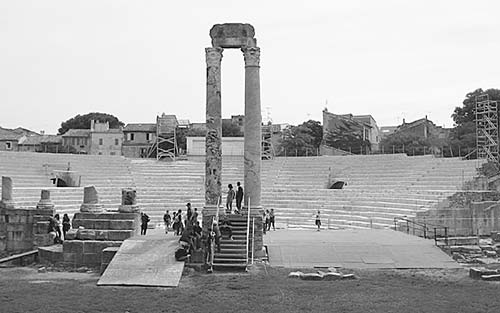
Cost and Hours: €9 combo-ticket with Roman Arena, same hours as Arena.
Visiting the Theater: Start with the 10-minute video, which provides background information that makes it easier to imagine the scattered stones back in place (crouch in front to make out the small English subtitles).
Then walk into the theater and pull up a stone seat in a center aisle. (For more context, read the description of Orange’s Roman theater on here while you rest.) Imagine that for 500 years, ancient Romans gathered here for entertainment. The original structure was much higher, with 33 rows of seats covering three levels to accommodate demand. During the Middle Ages, the old theater became a convenient town quarry—much of St. Trophime Church was built from theater rubble. Precious little of the original theater survives—though it still is used for events, with seating for 2,000 spectators.
Two lonely Corinthian columns are all that remain of a three-story stage wall that once featured more than 100 columns and statues painted in vibrant colors (a model in the Ancient History Museum shows the complete theater). Principal actors entered through the central arch, over which a grandiose statue of Caesar Augustus stood (it’s now on display at the Ancient History Museum).
• From the theater, walk downhill on Rue de la Calade. As you stroll, enjoy the fine facades of 17th- and 18th-century mansions. Take the first left into a big square.
This square used to be called “Place Royale”...until the French Revolution. The obelisk was the former centerpiece of Arles’ Roman Circus (outside of town). The lions at its base are the symbol of the city, whose slogan is (roughly) “the gentle lion.” Observe the age-old scene: tourists, peasants, shoppers, pilgrims, children, and street musicians. The City Hall (Hôtel de Ville) has a stately facade, built in the same generation as Versailles. Where there’s a City Hall, there’s always a free WC (if you win the Revolution, you can pee for free at the mayor’s home). Notice the flags: The yellow-and-red of Provence is the same as the yellow-and-red of Catalunya, its linguistic cousin in Spain.
• Today’s City Hall sits upon an ancient city center. Inside, admire the engineering of the ceiling and find the entrance to an ancient cryptoportico (foundation).
This dark, drippy underworld of Roman arches was constructed to support the upper half of Forum Square (necessary for a big, level square in a town built on a slope). Two thousand years ago, most of this gallery of arches was at or above street level; modern Arles has buried about 20 feet of its history over the millennia. Through the tiny windows high up you would have seen the sandals of Romans on their way to the forum. Other than dark arches and broken bits of forum littering the dirt floor, there’s not much down here beyond ancient memories (€4.50, same hours as Arena).
• The highlight of Place de la République is...
Named after a third-century bishop of Arles, this church, worth ▲▲, sports the finest Romanesque main entrance I’ve seen anywhere. The Romanesque and Gothic interior—with tapestries, relics, and a rare painting from the French Revolution when this was a “Temple of Reason”—is worth a visit.
Cost and Hours: Free, daily 9:00-12:00 & 14:00-18:30, Oct-March until 17:00.
Exterior: Like a Roman triumphal arch, the church facade trumpets the promise of Judgment Day. The tympanum (the semicircular area above the door) is filled with Christian symbolism. Christ sits in majesty, surrounded by symbols of the four evangelists: Matthew (the winged man), Mark (the winged lion), Luke (the ox), and John (the eagle). The 12 apostles are lined up below Jesus. It’s Judgment Day...some are saved and others aren’t. Notice the condemned (on the right)—a chain gang doing a sad bunny-hop over the fires of hell. For them, the tune trumpeted by the three angels above Christ is not a happy one. Below the chain gang, St. Stephen is being stoned to death, with his soul leaving through his mouth and instantly being welcomed by angels. Study the exquisite detail. In an illiterate world, long before the vivid images of our Technicolor time, this was colorfully painted, like a neon billboard over the town square. It’s full of meaning, and a medieval pilgrim understood it all.

Interior: Just inside the door on the right, a yellow chart locates the interior highlights and helps explain the carvings you just saw on the tympanum. The tall 12th-century Romanesque nave is decorated by a set of tapestries (typical in the Middle Ages) showing scenes from the life of Mary (17th century, from the French town of Aubusson).
This church is a stop on the ancient pilgrimage route to Santiago de Compostela in northwest Spain. For 800 years pilgrims on their way to Santiago have paused here...and they still do today. Notice the modern-day pilgrimages advertised on the far right near the church’s entry.
• To reach the adjacent peaceful cloister, leave the church, turn left, then left again through a courtyard.
Worth seeing if you have an Arles sightseeing pass (otherwise €5.50, same hours as Arena), the cloisters’ many small columns were scavenged from the ancient Roman theater and used to create an oasis of peace in Arles’ center. Enjoy the delicate, sculpted capitals, the rounded Romanesque arches (12th century), and the pointed Gothic ones (14th century). The pretty vaulted hall exhibits 17th-century tapestries showing scenes from the First Crusade to the Holy Land. There’s an instructive video and a chance to walk outside along an angled rooftop designed to catch rainwater: Notice the slanted gutter that channeled the water into a cistern and the heavy roof slabs covering the tapestry hall below.
• From Place de la République, exit on the far corner (opposite the church and kitty-corner from where you entered) to stroll a delightful pedestrian street.
Rue da la République is Arles’ primary shopping street. Walk downhill, enjoying the scene and popping into shops that catch your interest.
Near the start is Maison Soulier Bakery. Inside you’ll be tempted by fougasse (bread studded with herbs, olives, and bacon bits), sablés Provençal (cookies made with honey and almonds), tarte lavande (a sweet almond lavender tart), and big crispy meringues (the egg-white-and-sugar answer to cotton candy—a cheap favorite of local kids). They also have sandwiches and salads if you feel like a picnic on the square. A few doors down is Restaurant L’Atelier (around the corner, with two prized Michelin stars), L’Occitane en Provence (local perfumes), Puyricard Chocolate (with enticing €1 treats and calisson, a sweet almond delight), as well as local design and antique shops. The fragile spiral columns on the left (just before the tourist-pleasing Lavender Boutique on the corner) show what 400 years of weather can do to decorative stonework. The big Arlaten Folk Museum is up on the right.
• Take the first left onto Rue Président Wilson. (Wilson was so honored by the French for his noble efforts to create the League of Nations—a proto-UN—after World War I.) Just after the butcher shop (Chez Mère Grand, with local pork-and-bull sausages hanging above a counter filled with precooked dishes to take home and heat up), turn right to find the Hôtel Dieu, a hospital made famous by one of its patients: Vincent van Gogh.
In December 1888, shortly after his famous ear-cutting incident (see Café Terrace at Night easel, described later), Vincent was admitted into the local hospital—today’s Espace Van Gogh cultural center. The Espace—with its exhibit space, classrooms, and library—is free (there’s a handy WC inside). It surrounds a flowery courtyard (open to the public) that the artist loved and painted when he was being treated for blood loss, hallucinations, and severe depression that left him bedridden for a month. The citizens of Arles circulated a petition demanding that the mad Dutchman be kept under medical supervision. Félix Rey, Vincent’s kind doctor, worked out a compromise: The artist could leave during the day so that he could continue painting, but he had to sleep at the hospital at night. Look through the postcards sold in the courtyard to enjoy a tour of Arles through the eyes of Vincent. Find a painting of Vincent’s ward—that’s right here—showing nuns attending to patients in a gray hall (Ward of Arles Hospital).
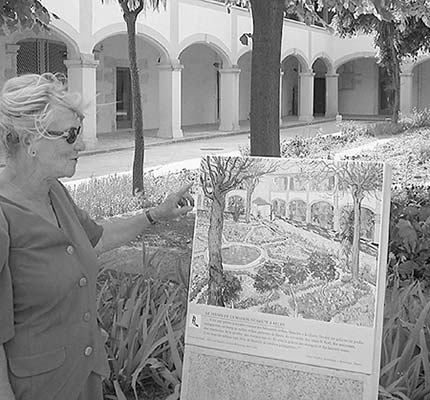
• Return to Rue de la République. Take a left and continue two blocks downhill. Take the second right up Rue Tour de Fabre and follow signs to Fondation Van Gogh. After a few steps, you’ll pass La Main Qui Pense (The Hand That Thinks) pottery shop and workshop, where Cécile Cayrol is busy creating and teaching. A couple of blocks farther down, turn right onto Rue du Docteur Fanton. On your immediate right is the...
This art foundation, worth ▲, delivers a refreshing stop for modern-art lovers and Van Gogh fans, with two temporary exhibits per year in which contemporary artists pay homage to Vincent with thought-provoking interpretations of his works. You’ll also see at least one original work by Van Gogh (painted during his time in the region). The gift shop has a variety of souvenirs, prints, and postcards.
Cost and Hours: €9, discount with sightseeing passes; daily 11:00-19:00, July-Aug from 10:00, Oct-March until 17:45, closed Mon off-season—check website for current hours and what’s on; audioguide-€3, 35 Rue du Docteur Fanton, tel. 04 90 49 94 04, www.fondation-vincentvangogh-arles.org.
• Continue on Rue du Docteur Fanton.
A string of recommended restaurants is on the left. On the right is the Crèche Municipale. Open workdays, this is a free government-funded daycare where parents can drop off their infants up to two years old. The notion: No worker should face financial hardship in order to receive quality childcare. At the next corner is the recommended Soleileïs, Arles’ top ice cream shop.
After the ice cream shop, turn right and step into Bar El Paseo at 4 Rue des Thermes. This little restaurant is run by the Leal family, famous for its “dynasty” of bullfighters and proud of its bullfighting lore. They’ve lovingly wallpapered the place with photos and bullfighting memorabilia. The main museum-like room is full of bull—including the mounted heads of three big ones who died in the local arena and a big black-and-white photo of Arles’ arena packed to capacity. You’re welcome to look around...and even more welcome to buy a glass of Spanish Rioja wine or sangria.
• A few steps farther is...
Named for the Roman forum that once stood here, Forum Square, worth ▲, was the political and religious center of Roman Arles. Still lively, this café-crammed square is a local watering hole and popular for a pastis (anise-based aperitif). The bistros on the square can put together a passable salad or plat du jour—and when you sprinkle on the ambience, that’s €14 well spent.

At the corner of Grand Hôtel Nord-Pinus, a plaque shows how the Romans built a foundation of galleries to make the main square level in order to compensate for Arles’ slope down to the river. The two columns are all that survive from the upper story of the entry to the forum.
The statue on the square is of Frédéric Mistral (1830-1914). This popular poet, who wrote in the local dialect rather than in French, was a champion of Provençal culture. After receiving the Nobel Prize in Literature in 1904, Mistral used his prize money to preserve and display the folk identity of Provence. He founded a regional folk museum (the Arlaten Folk Museum) at a time when France was rapidly centralizing and regions like Provence were losing their unique identities. (The local mistral wind—literally “master”—has nothing to do with his name.)
• Facing the brightly painted yellow café, find your final Van Gogh easel—Café Terrace at Night.
In October 1888, lonely Vincent—who dreamed of making Arles a magnet for fellow artists—persuaded his friend Paul Gauguin to come. He decorated Gauguin’s room with several humble canvases of sunflowers (now some of the world’s priciest paintings), knowing that Gauguin had admired a similar painting he’d done in Paris. Their plan was for Gauguin to be the “dean” of a new art school in Arles, and Vincent its instructor-in-chief. At first, the two got along well. They spent days side by side, rendering the same subjects in their two distinct styles. At night they hit the bars and brothels. Van Gogh’s well-known Café Terrace at Night captures the glow of an absinthe buzz at Café la Nuit on Place du Forum.
After two months together, the two artists clashed over art and personality differences (Vincent was a slob around the house, whereas Gauguin was meticulous). The night of December 23, they were drinking absinthe at the café when Vincent suddenly went ballistic. He threw his glass at Gauguin. Gauguin left. Walking through Place Victor Hugo, Gauguin heard footsteps behind him and turned to see Vincent coming at him, brandishing a razor. Gauguin quickly fled town. The local paper reported what happened next: “At 11:30 p.m., Vincent van Gogh, painter from Holland, appeared at the brothel at no. 1, asked for Rachel, and gave her his cut-off earlobe, saying, ‘Treasure this precious object.’ Then he vanished.” He woke up the next morning at home with his head wrapped in a bloody towel and his earlobe missing. Was Vincent emulating a successful matador, whose prize is cutting off the bull’s ear?
The bright-yellow café—called Café la Nuit—was the subject of one of Vincent van Gogh’s most famous works in Arles. Although his painting showed the café in a brilliant yellow from the glow of gas lamps, the facade was bare limestone, just like the other cafés on this square. The café is now a tourist trap that its current owners painted to match Van Gogh’s version...and to cash in on the Vincent-crazed hordes who pay too much to eat or drink here.
In spring 1889, the bipolar genius (a modern diagnosis) checked himself into the St. Paul Monastery and Hospital in St-Rémy-de-Provence (described later, under “Sights in St-Rémy”). He spent a year there, thriving in the care of nurturing doctors and nuns. Painting was part of his therapy, so they gave him a studio to work in, and he produced more than 100 paintings. Alcohol-free and institutionalized, he did some of his wildest work. With thick, swirling brushstrokes and surreal colors, he made his placid surroundings throb with restless energy.
Eventually, Vincent’s torment became unbearable. In the spring of 1890, he left Provence to be cared for by a sympathetic doctor in Auvers-sur-Oise, just north of Paris. On July 27, he wandered into a field and shot himself. He died two days later.
• With this walk, you have seen the best of Arles. The colorful Roquette District, the Arlaten Folk Museum, and the Réattu Museum are each a short walk away (all described next). But I’d rather enjoy a drink on the Place du Forum and savor the joy of experiencing the essence of Provence.
Many of Arles’ city-center sights (such as the Roman Arena and St. Trophime church) are covered on my self-guided walk. Here are a few more worthwhile things to see on your visit.
This is the leading museum in Provence for traditional culture and folklore. After a long closure for renovation, it may reopen by the time you visit. When it does, it is expected to resume its place as one of the top attractions in Arles.
Cost and Hours: Reopening in 2019—check ahead for price and open days. Tel. 04 13 31 51 99, www.museonarlaten.fr.
To escape the tourist beat in Arles, take a detour into the town’s little-visited western fringe. Find Rue des Porcelets near the Trinquetaille Bridge and stroll several blocks into pleasing Place Paul Doumer, where you’ll find a lively assortment of cafés, bakeries, and bistros catering to locals (see “Eating in Arles,” later, for my suggestions). Continue along Rue de la Roquette and turn right on charming Rue Croix Rouge to reach the river. Those walking to or from the Ancient History Museum can use this appealing stroll as a shortcut.
Housed in the former Grand Priory of the Knights of Malta, this modern-art collection, while always changing, is a stimulating and well-lit mix of new and old. Picasso loved Arles and came here regularly for the bullfights. At the end of his life in 1973, he gave the city a series of his paintings, some of which are always on display here. The permanent collection usually includes a series of works by homegrown Neoclassical artist Jacques Réattu.
Cost and Hours: €8; Tue-Sun 10:00-18:00, Nov-Feb until 17:00, closed Mon year-round; 10 Rue du Grand Prieuré, tel. 04 90 49 37 58, www.museereattu.arles.fr.
These partly intact Roman baths were built in the early fourth century when Emperor Constantine declared Arles an imperial residence. Roman cities such as Arles had several public baths like this, fed by aqueducts and used as much for exercising, networking, and chatting with friends as for bathing (like today’s athletic clubs). These baths were located near the Rhône River for easy water disposal. You can get a pretty good look at the baths through the fence. If you enter you’ll walk elevated metal corridors at the original floor level. Imagine the elaborate engineering: the hypocaust system for heating the floor and big tubs with various temperatures—hot, tepid, and cold—next to a sauna and steam room heated by slave-stoked, wood-burning ovens.
Cost and Hours: €4, daily 9:00-19:00, April and Oct until 18:00, Nov-March 10:00-17:00.
This museum, just west of central Arles along the river, provides valuable background on Arles’ Roman history: Visit it first, before delving into the rest of the city’s sights (drivers should stop on the way into town).
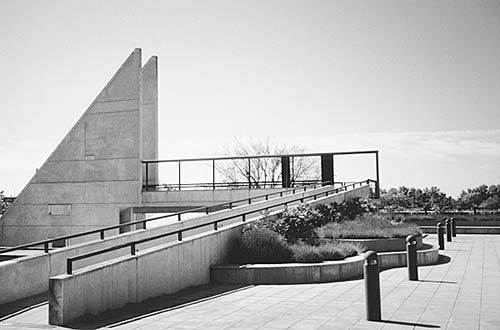
Located on the site of the Roman chariot racecourse (the arc of which defines today’s parking lot), this air-conditioned, all-on-one-floor museum is full of models and original sculptures that re-create the Roman city, making workaday life and culture easier to imagine. While the museum’s posted descriptions of most of its treasures are only in French, the audioguide does a fine job describing the exhibits in English. For a deeper understanding of Provence’s ancient roots, read “The Romans in Provence,” earlier.
Cost and Hours: €8, free first Sun of the month, Wed-Mon 10:00-18:00, closed Tue, audioguide-€2, Presqu’île du Cirque Romain, tel. 04 13 31 51 03.
Getting There: Drivers will see signs for the museum at the city’s western end. To reach the museum from the city center sans car, take the free Navia shuttle (see “Getting Around Arles,” earlier). The museum is about a 20-minute walk from the city center: Turn left at the river and take the riverside path under two bridges to the big, modern blue building (or better, stroll through Arles’ enjoyable La Roquette neighborhood, described earlier). As you approach the museum, you’ll pass the verdant Hortus Garden—designed to recall the Roman circus and chariot racecourse that were located here. A taxi ride costs about €12 (museum can call a taxi for your return).
Visiting the Museum: The permanent collection is housed in a large hall flooded with natural light. Highlights include models of the ancient city and its major landmarks, a 2,000-year-old Roman boat, statues, mosaics, and sarcophagi. Here’s what you’ll see:
A wall map of the region during the Roman era greets visitors and shows the geographic importance of Arles: Three important Roman trade routes—vias Domitia, Grippa, and Aurelia—all converged on or near Arles.
After a small exhibit on pre-Roman Arles you’ll come to fascinating models of the Roman city and the impressive Roman structures in (and near) Arles. These breathe life into the buildings, showing how they looked 2,000 years ago.

Start with the model of Roman Arles and ponder the city’s splendor when Arles’ population was almost double that of today. Find the forum—it’s still the center of town, although only two columns survive (the smaller section of the forum is where today’s Place du Forum is built). The next model shows the grandeur of the forum in greater detail.
At the museum’s center stands the original statue of Julius Caesar, which once graced Arles’ ancient theater’s magnificent stage wall. To the left of Julius, find a model of Arles’ theater and its wall, as well as models of the ancient town’s other major buildings. Find the arena with its movable cover to shelter spectators from sun or rain, the floating wooden bridge over the widest, slowest part of the river—giving Arles a strategic advantage—and the hydraulic mill of Barbegal with its 16 waterwheels cascading water down a hillside.
Step down into the hall to Julius’s right and find the large model of the chariot racecourse. Part of the original racecourse was just outside the windows, and although long gone, it likely resembled Rome’s Circus Maximus. The rest of this hall is dedicated to the museum’s newest and most exciting exhibit: a Gallo-Roman vessel and much of its cargo (English translations on panels). This almost-100-foot-long Roman barge was hauled out of the Rhône in 2010, along with some 280 amphorae and 3,000 ceramic artifacts. It was typical of flat-bottomed barges used to shuttle goods between Arles and ports along the Mediterranean (vessels were manually towed upriver). This one hauled limestone slabs and big rocks—no wonder it sank. A worthwhile 20-minute video about the barge’s recovery (with English subtitles) plays continuously in a tiny theater at the end of the hall.
Elsewhere in the museum, you’ll see displays of pottery, jewelry, metal, and glass artifacts. You’ll also see well-crafted mosaic floors that illustrate how Roman Arles was a city of art and culture. The many statues are all original, except for the greatest—the Venus of Arles, which Louis XIV took a liking to and had moved to Versailles.
The buzz in Arles is the 180-foot-tall Gehry-designed aluminum tower rising in a rundown neighborhood southeast of the center. The once thriving railyard quarter, which never recovered after WWII bombings, will enjoy this futuristic facelift. The tower is part of the new LUMA Arles and will provide a space for independent artists and special expositions. The project promises to revitalize this zone with galleries and apartments (opens in 2019, 45 Chemin des Minimes, tel. 04 90 47 76 17, www.luma-arles.org).
Knocking on Arles’ doorstep, the Camargue region, occupying the vast delta of the Rhône River, is one of Europe’s most important wetlands. This marshy area exists where the Rhône splits into two branches (big and little), just before it flows into the Mediterranean. Over the millennia, a steady flow of sediment has been deposited at the mouth of the rivers—thoroughly land-locking villages that once faced the sea.

Today the Camargue Regional Nature Park is a protected “wild” area, where pink flamingos, wild bulls, nasty boars, nastier mosquitoes (in every season but winter—come prepared), and the famous white horses wander freely through lagoons and tall grass. The dark bulls are harder to spot than the white horses and flamingos, so go slow and make use of the viewing platforms.
The best time to visit is in spring, when the flamingos are out in full force; the worst time to visit is in summer, when birds are fewest and the mosquitoes are most abundant.
Camargue Scenic Drive: My favorite route is toward Salin de Giraud (see map on previous page): Leave Arles driving clockwise on its ring road, then find signs to Stes-Maries-de-la-Mer and join D-570. Skip the D-36 turnoff to Salin de Giraud (you’ll return along this route). After about 3.5 miles (6 kilometers), enthusiasts can consider a stop at the Camargue Museum (folk museum with a two-mile nature trail, closed Tue in off-season, www.parc-camargue.fr). Next, continue along D-570 past swampy rice fields, then turn left on D-37 and follow it as it skirts the Etang de Vaccarès lagoon. The lagoon is off-limits, but this area has opportunities to get out of the car for views and to smell the marshes (look for viewing stands, but any dirt turnoff works). Turn right off D-37 onto the tiny road at Villeneuve, following signs for C-134 to La Capelière and La Fiélouse (poorly marked—it’s where D-36b leads back to Arles).
Make time for a stop at La Capelière (headquarters for Camargue sightseers), where you can pick up a good map, ask the staff questions, and enjoy an exhibit (small fee, handheld English explanations) and one-mile walking trail with some English information on the Camargue (daily 9:00-13:00 & 14:00-18:00, Oct-March until 17:00). Birders can check the register to see what birds have been spotted recently (observations in English are in red), and can buy the Camargue booklet in English.
The best part of this drive (particularly in spring) is the next stretch to and around La Digue de la Mer, about six scenic miles past La Capelière, where you’re most likely to witness the memorable sight of platoons of flamingos in flight. At La Digue de la Mer, get out of your car and walk a few hundred yards past the pavement’s end, where the dirt road curves left, to reach a good spot. This is a critical reproduction area for flamingos (about 13,000 couples produce 5,000 offspring annually). If you rented a mountain bike, now would be the right time to use it: It’s about eight bumpy but engaging miles between water and sand dunes to Stes-Maries-de-la-Mer.
From here, most will want to retrace their route back to Villeneuve, then continue straight onto D-36b, which leads back to Arles.
On Wednesday and Saturday mornings, Arles’ ring road erupts into an open-air festival of fish, flowers, produce...and everything Provençal. The main event is on Saturday, with vendors jamming the ring road from Boulevard Emile Combes to the east, along Boulevard des Lices near the TI (the heart of the market), and continuing down Boulevard Georges Clemenceau to the west. Wednesday’s market runs only along Boulevard Emile Combes, between Place Lamartine and Avenue Victor Hugo; the segment nearest Place Lamartine is all about food, and the upper half features clothing, tablecloths, purses, and so on. On the first Wednesday of the month, a flea market doubles the size of the usual Wednesday market along Boulevard des Lices near the TI. Both markets are open until about 12:30.
Provençal “bullgames” are held in Arles and in neighboring towns. Those in Arles occupy the same seats that fans have used for nearly 2,000 years, and deliver the city’s most memorable experience—the courses camarguaises in the ancient arena. The nonviolent bullgames are more sporting than bloody bullfights (though traditional Spanish-style bullfights still take place on occasion). The bulls of Arles (who, locals insist, “die of old age”) are promoted in posters even more boldly than their human foes. In the bullgame, a ribbon (cocarde) is laced between the bull’s horns. The razeteur, dressed in white and carrying a special hook, has 15 minutes to snare the ribbon. Local businessmen encourage a razeteur by shouting out how much money they’ll pay for the cocarde. If the bull pulls a good stunt, the band plays the famous “Toreador” song from Carmen. The following day, newspapers report on the games, including how many Carmens the bull earned.
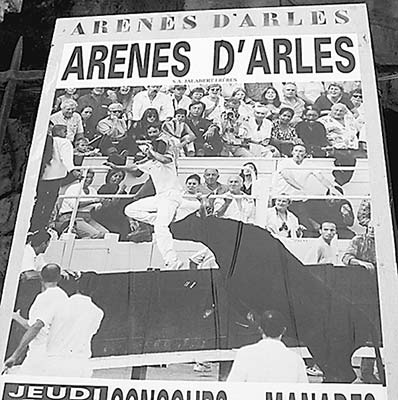
Three classes of bullgames—determined by the experience of the razeteurs—are advertised in posters: The Course de Protection is for rookies. The Trophée de l’Avenir comes with more experience. And the Trophée des As features top professionals. During Easter (Féria de Pâques) and the fall rice-harvest festival (Féria du Riz), the arena hosts traditional Spanish bullfights (look for corrida) with outfits, swords, spikes, and the whole gory shebang. (Nearby villages stage courses camarguaises in small wooden bullrings nearly every weekend; TIs have the latest schedule.)
Bullgame tickets usually run €11-20; bullfights are pricier (€36-100). Schedules for bullgames vary (usually July-Aug on Wed and Fri)—ask at the TI or check www.arenes-arles.com.
The local “bouling alleys” are by the Alyscamps necropolis (a block outside the ring road and sometimes by the river on Place Lamartine). Watch the old boys congregate for a game of pétanque after their afternoon naps (see “The Rules of Boules” sidebar, earlier in this chapter, for more on this popular local pastime).
Hotels are a great value here—most are air-conditioned, though few have elevators. The Calendal, Musée, and Régence hotels offer exceptional value.
$$ Hôtel le Calendal*** is a service-with-a-smile place ideally located between the Roman Arena and Classical Theater. The hotel opens to the street with airy lounges and a lovely palm-shaded courtyard, providing an enjoyable refuge. You’ll find snacks and drinks in the café/sandwich bar (daily 8:00-20:00). The soothing rooms show a modern flair with creations from local artists (and explanations of their art). Rooms come in all shapes and sizes (some with balcony, family rooms, air-con, free spa for adults, ask about parking deals, just above arena at 5 Rue Porte de Laure, tel. 04 90 96 11 89, www.lecalendal.com, contact@lecalendal.com). They also run the nearby budget Hostel Arles City Center, described later.
$ Hôtel du Musée** is a quiet, affordable manor-home hideaway tucked deep in Arles (if driving, call the hotel from the street—they’ll open the barrier so you can drive in to drop off your bags). This delightful place comes with 29 tasteful rooms, a flowery courtyard, and comfortable lounges. Lighthearted Claude and English-speaking Laurence are good hosts (family rooms, no elevator, pay parking garage, follow Réattu Museum signs to 11 Rue du Grand Prieuré, tel. 04 90 93 88 88, www.hoteldumusee.com, contact@hoteldumusee.com).
$ Hôtel de la Muette** is an intimate, good-value hotel located in a quiet corner of Arles, run by hard-working owners Brigitte and Alain. Its sharp rooms and bathrooms come with tiled floors and stone walls (RS%, family rooms, no elevator, pay private garage, 15 Rue des Suisses, tel. 04 90 96 15 39, www.hotel-muette.com, hotel.muette@wanadoo.fr).
$ Hôtel Régence** is a top budget deal with a riverfront location, comfortable, Provençal rooms, and easy parking. Of all the hotels I list, this one is the closest to the train station—a 10-minute walk (family rooms, choose river-view or quieter courtyard rooms, no elevator; from Place Lamartine, turn right after passing between towers to reach 5 Rue Marius Jouveau; tel. 04 90 96 39 85, www.hotel-regence.com, contact@hotel-regence.com). Gentle Valérie and Eric speak English.
$ Hôtel Acacias*** sits just off Place Lamartine and inside the old city walls. It’s a modern hotel with small, clean, and comfortable rooms (family rooms, air-con, pay parking garage, 2 Rue de la Cavalerie, tel. 04 90 96 37 88, https://hotel-arles.brithotel.fr, arles@brithotel.fr).
¢ Hostel Arles City Center offers good four-bed dorm rooms, a shared kitchen, and homey living area. It’s a great value for backpackers and those on a shoestring. Check in next door at the recommended Hôtel le Calendal (air-con, just above the Roman Arena at 26 Place Pomme, mobile 06 99 71 11 89, www.arles-pelerins.fr).
Many drivers, particularly those with families, prefer staying outside Arles in the peaceful countryside, with easy access to the area’s sights. For locations, see the “Near Arles” map.
$$ Mas Petit Fourchon is a grand farmhouse with spacious rooms on a sprawling property a few minutes from Arles. There’s acres of room to roam and a big, heated pool (includes breakfast, some rooms with air-con, 1070 Chemin de Nadal in the Fourchon suburb; take exit 6 from N-113 toward l’hôpital, turn right just after the hospital and follow signs; tel. 04 90 96 16 35, www.petitfourchon.com, info@petitfourchon.com).
$ Domaine de Laforest, a few minutes’ drive below Fontvieille, near the aqueduct of Barbegal, is a 320-acre spread engulfed by vineyards, rice fields, and swaying trees. The sweet owners (Sylvie and mama Mariette) rent eight well-equipped and comfortable two-bedroom apartments with great weekly rates (may be rentable for fewer days, air-con, washing machines, pool, big lawn, swings, 1000 Route de l’Aqueduc Romain, mobile 06 23 73 44 59, www.domaine-laforest.com, contact@domaine-laforest.com).
You can dine well in Arles on a modest budget (most of my listings have menus for under €25). Sunday is a quiet night for restaurants, though eateries on Place du Forum are open. For a portable snack, try Maison Soulier Bakery (see my “Arles City Walk,” earlier), and for groceries, use the big Monoprix supermarket/department store on Place Lamartine (Mon-Sat 8:30-19:30, closed Sun).
$ Café Factory République is a youthful, creative, and fun-loving place run by jovial Gilles. He’s fun to talk with and serves sandwiches, hearty salads, and a wide variety of drinks. While not really a dinner place, he takes orders until 18:00 (Mon-Sat 8:00-19:00, closed Sun, 35 Rue de la République, tel. 04 90 54 52 23, skinniest WC in France).
$ Le Comptoir du Calendal, in the recommended Hôtel le Calendal, serves light, seasonal fare either curbside overlooking the arena, in its lovely courtyard, or inside the café—order at the counter (delicious and cheap little sandwiches and salads, daily 8:00-20:00, guest computer available, 5 Rue Porte de Laure, tel. 04 90 96 11 89).
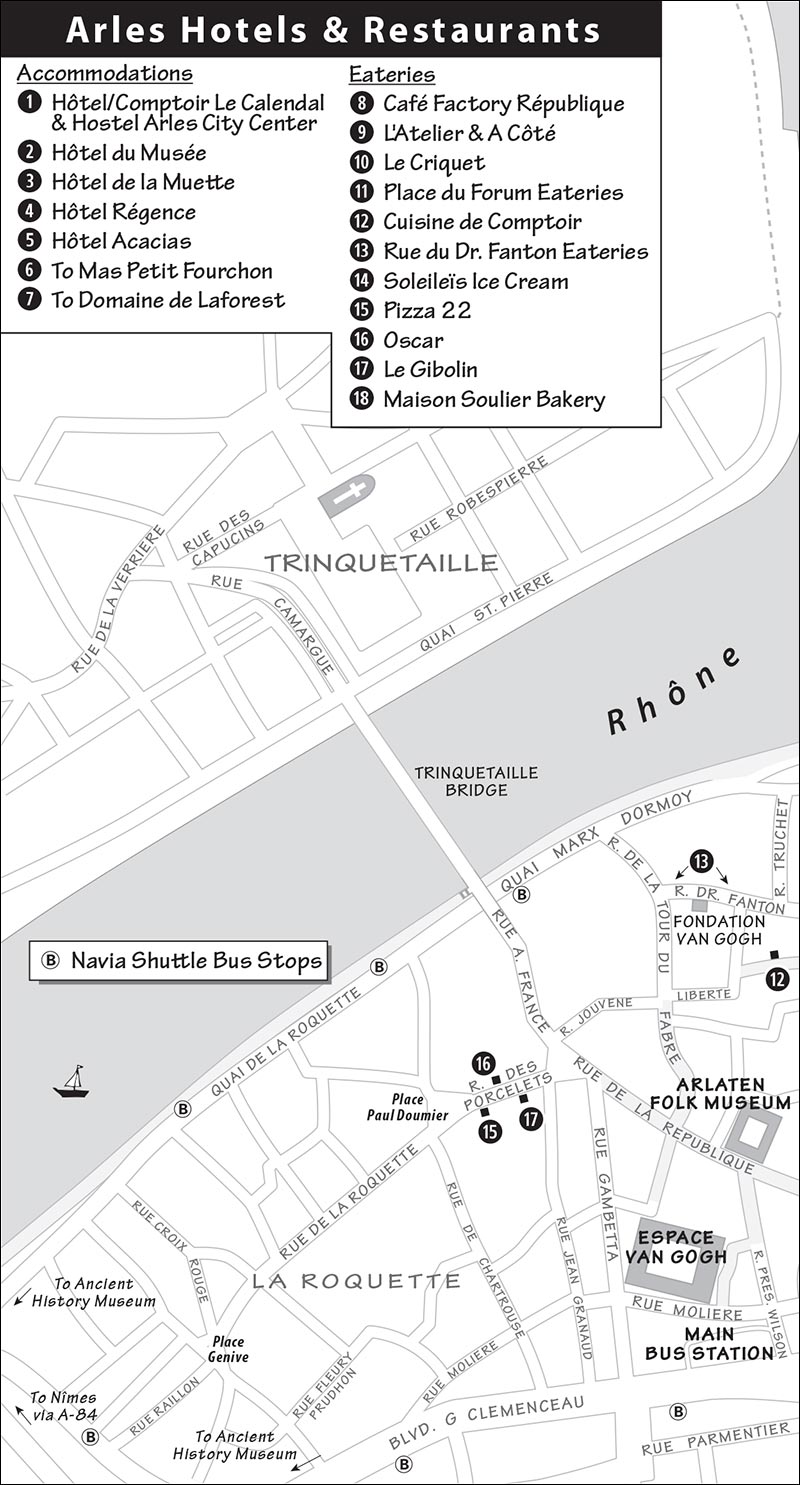
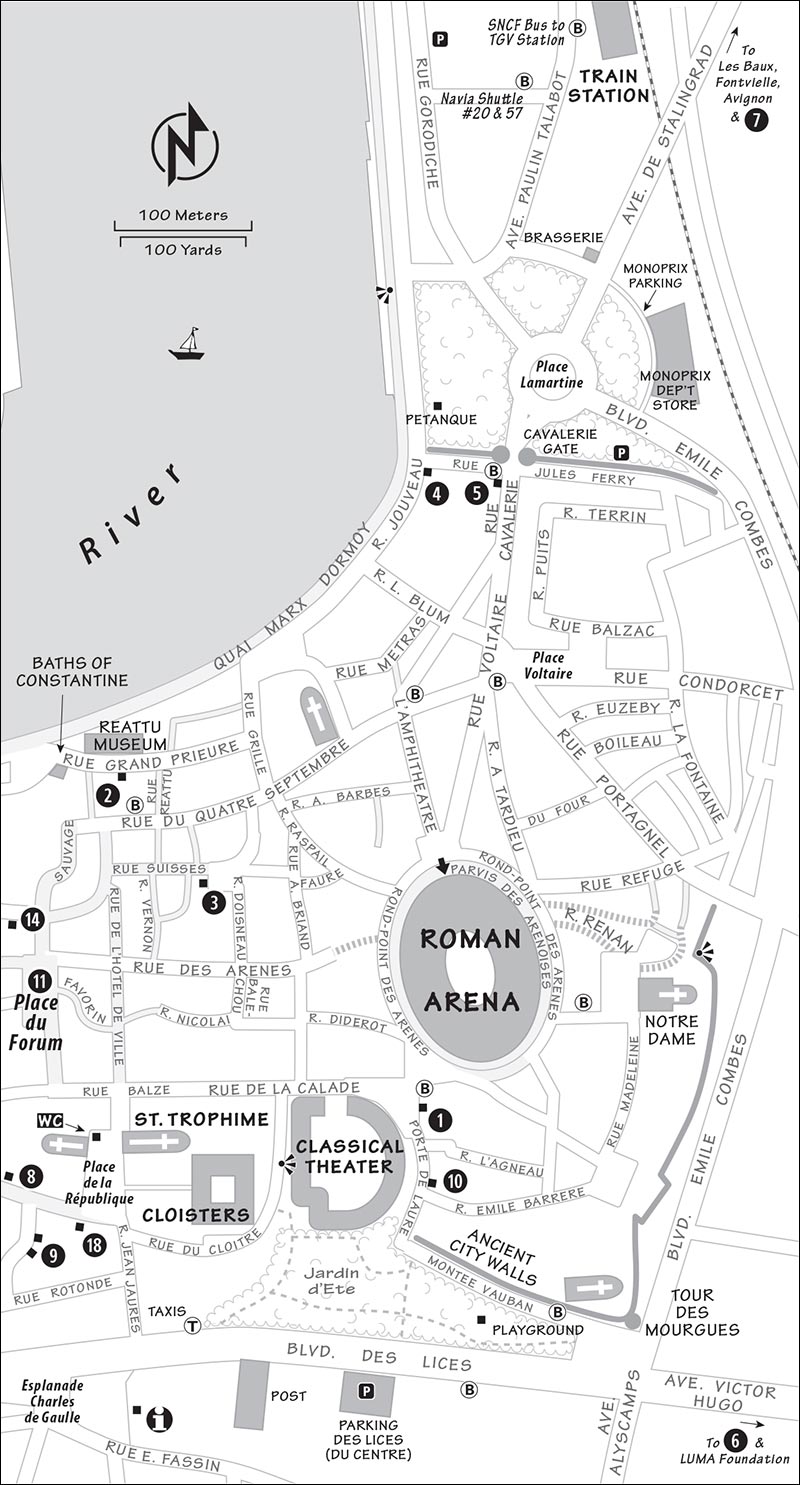

(See “Arles Hotels & Restaurants” map.)
One of France’s most recognized chefs, Jean-Luc Rabanel, runs two very different places 50 yards from Place de la République. They sit side by side at 7 Rue des Carmes. $$$$ L’Atelier is a top-end place with two Michelin stars (contemporary tasting menus only—around €125, closed Mon-Tue, tel. 04 90 91 07 69). And next door is $$$ A Côté, a place with all the quality, none of the pretense, and meals at a fraction of the price. It offers a smart wine bar/bistro ambience and fine cuisine. This is a wonderful opportunity to sample the famous chef’s talents with the €32 three-course menu (limited selection of wines by the glass, closed Mon-Tue, tel. 04 90 47 61 13, www.rabanel.com).
$$ Le Criquet, possibly the best value in Arles, is a sweet little place two blocks above the arena, serving well-presented and delicious Provençal classics with joy at good prices. Sisters Lili and Charlotte serve while mama and papa run the kitchen. Their mouthwatering €25 bourride is the house specialty: a creamy fish soup thickened with aioli and lots of garlic and stuffed with mussels, clams, calamari, and more—but every dish is tasty here. They have a lovely dining room and a petite terrace (closed Sun and Wed, 21 Rue Porte de Laure, tel. 04 90 96 80 51).
(See “Arles Hotels & Restaurants” map.)
The most charming square in town is also the most touristy. While you feel sure Van Gogh sipped his pastis here, these days he’d avoid it. Still, if you want to enjoy forgettable food with unforgettable atmosphere under a starry, starry night, Place du Forum is a winner.
For dinner: Circle the square to compare the ambience and crowds. You don’t need a reservation here, so keep your options open. Your best bets for a good $$ meal are probably Le Tambourin at the top of the square (good dinner salads and more) and Mon Bar Brasserie at the bottom (most local crowd, decent-value plates). La Taverne du Forum always seems the liveliest with the least lively food. Le Comptoir d’Italie serves your basic Italian grub, pizzas, and salads. Apostrophe Café has a younger vibe, more modern food, and smoothies. Le Café La Nuit may have the best street appeal, but it’s a tourist trap designed to hook those with Vincent fantasies.
Before-Dinner Drink or Dessert: You can eat at a better restaurant elsewhere and enjoy the ambience of Place du Forum for an aperitif or dessert. Any bar can serve you a pastis—one of the most local rituals you can enjoy in Arles. This anise-based aperitif is served straight with ice, along with a carafe of water—dilute to taste. And the ice cream shop on the square has a handful of tables, giving you a front-row seat to the Provençal ambience.
(See “Arles Hotels & Restaurants” map.)
$ Cuisine de Comptoir offers light and cheap dinners of tartine—a cross between pizza and bruschetta, served with soup or salad for €11—and offers a fun array of pizza-style tartine toppings. This Provençal answer to a pizzeria—run by Vincent—has indoor seating only (closed Sun, off lower end of square at 10 Rue de la Liberté, tel. 04 90 96 86 28).
(See “Arles Hotels & Restaurants” map.)
$$$ Le Galoubet is a popular local spot, blending a warm interior, traditional French cuisine, and gregarious service, thanks to owner Frank. It’s the most expensive and least flexible place on the street, serving menus only. If it’s cold, a roaring fire keeps you toasty (closed Sun-Mon, great fries and desserts, at #18, tel. 04 90 93 18 11).
$$ Les Filles du 16 is a warm, affordable place to enjoy a good Provençal two- or three-course dinner. The choices, while tasty, are limited, so check the selection before sitting down (closed Sat-Sun, at #16, tel. 04 90 93 77 36).
$$ Le Plaza la Paillotte buzzes with happy diners enjoying delicious, well-presented Provençal cuisine. Attentive owners Stéphane and Graziela (he cooks, she serves) welcome diners with a comfortable terrace and a smart interior (open daily, at #28, tel. 04 90 96 33 15).
Ice Cream: At Soleileïs, Marijtje scoops up fine ice cream made with organic milk, fresh fruit, all-natural ingredients, and creative flavors that fit the season. There’s also a shelf of English books for exchange (daily 14:00-18:30, closed in winter, at #9).
(See “Arles Hotels & Restaurants” map.)
For a less-touristy-feeling dining experience, wander into the La Roquette neighborhood (described earlier, under “Sights in Arles”).
$ Pizza 22 fires up the best pizza in Arles with inviting tables on Place Paul Doumer (closed Tue, 22 Place Paul Doumer, tel. 04 86 63 65 60).
$ Oscar is an intriguing place with a young chef, an open kitchen, and a dining room that feels like a retro-chic art gallery/diner hybrid. The silverware sits in a jar on your table next to the napkin dispenser, while revolving photo exhibits decorate the walls. They offer eight or so seasonal plates designed to be eaten family style (about €12 each, three will fill two people). They also serve good wines by the glass (closed Wed, 20 Rue des Porcelets, tel. 04 90 99 53 12).
$$ Le Gibolin, while less convivial, is an intimate place with a warm interior where you’ll eat surrounded by wine bottles and locals. There is no à la carte, just two- or three-course menus (closed Sun-Mon, 13 Rue des Porcelets, tel. 04 88 65 43 14).
Note that Intercité trains in and out of Arles require a reservation. These include connections with Nice to the east and Bordeaux to the west (including intermediary stops). Ask at the station.
Compare train and bus schedules: For some nearby destinations the bus may be the better choice, and it’s usually cheaper.
From Arles by Train to: Paris (hourly, 4 hours, transfer in Avignon or Nîmes; or take the SNCF bus to Avignon TGV Station and train from there), Avignon Centre-Ville (hourly, 20 minutes), Nîmes (hourly, 30 minutes), Orange (4/day direct, 30 minutes, more with transfer in Avignon), Aix-en-Provence Centre-Ville (hourly, 2 hours, transfer in Marseille, train may separate midway—be sure your section is going to Aix-en-Provence), Marseille (hourly, 1 hour), Cassis (7/day, 2 hours), Carcassonne (4/day direct, 2.5 hours, more with transfer in Narbonne, direct trains may require reservations), Beaune (hourly, 5 hours, transfer in Lyon), Nice (hourly, 4 hours, most require transfer in Marseille), Barcelona (3/day, 4.5 hours, transfer in Nîmes), Italy (3/day, transfer in Marseille and Nice; from Arles, it’s 5 hours to Ventimiglia on the border, 8 hours to Milan, 9 hours to Cinque Terre, 11 hours to Florence, and 13 hours to Venice or Rome).
Arles’ main bus station is located on Boulevard Georges Clemenceau, a few blocks from the TI. Most buses to regional destinations depart from here, and most bus trips cost under €2. Get schedules at the TI or from the bus company (closed Sun, tel. 08 10 00 08 18, www.lepilote.com).
From Arles Train Station to Avignon TGV Station: The direct SNCF bus is your best option (€8, 8/day, 1 hour, included with rail pass). Though less convenient, you can also take the train from Arles to Avignon’s Centre-Ville Station, then catch the shuttle train to the TGV station (see here).
From Arles by Bus to Les Baux and St-Rémy: Cartreize bus #57 connects Arles to St-Rémy-de-Provence via Les Baux (6/day, daily July-Aug, Sat-Sun only in early May-June and Sept, none in off-season; departs from the train station, not the bus station; 35 minutes to Les Baux, 50 minutes to St-Rémy, then runs to Avignon). Bus #54 also goes to St-Rémy but not via Les Baux (5/day Mon-Fri, 3/day Sat, none on Sun, 1 hour).
By Bus to Other Destinations: Nîmes (8/day Mon-Fri, 2/day Sat-Sun, 1 hour), Aix-en-Provence (faster than trains, 6/day Mon-Fri, 4/day Sat-Sun, 1.5 hours), Fontvieille (6/day Mon-Sat, 2/day Sun, 20 minutes), Camargue/Stes-Maries-de-la-Mer (bus #20, 6/day Mon-Sat, 3/day Sun, departs from both the bus and train station, 1 hour).
Famous for its nursery rhyme, medieval bridge, and brooding Palace of the Popes, contemporary Avignon (ah-veen-yohn) bustles and prospers behind its mighty walls. For nearly 100 years (1309-1403) Avignon was the capital of Christendom, home to seven popes. (And, for a difficult period after that—during the Great Schism when there were two competing popes—Avignon was “the other Rome.”) During this time, it grew from a quiet village into a thriving city. Today, with its large student population and fashionable shops, Avignon is an intriguing blend of medieval history, youthful energy, and urban sophistication. Street performers entertain the international throngs who fill Avignon’s ubiquitous cafés and trendy boutiques. And each July the city goes pedal to the metal during its huge theater festival (with about 2,000 performances, big crowds, higher prices, and hotels booked up long in advance).
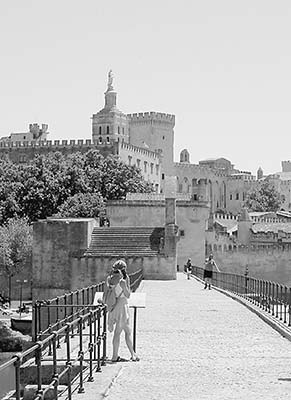
Cours Jean Jaurès, which turns into Rue de la République, runs straight from the Centre-Ville train station to Place de l’Horloge and the Palace of the Popes, splitting Avignon in two. The larger eastern half is where the action is. Climb to the Jardin du Rochers des Doms for the town’s best view, tour the pope’s immense palace, lose yourself in Avignon’s back streets (following my self-guided “Discovering Avignon’s Back Streets Walk”), and go organic in its vibrant market hall.
The TI is located on the main street linking the Centre-Ville train station to the old town (Mon-Sat 9:00-18:00 except Sat until 17:00 Nov-March, Sun 10:00-17:00 except until 12:00 Nov-March, daily until 19:00 in July, 41 Cours Jean Jaurès, tel. 04 32 74 32 74, www.avignon-tourisme.com).
At the TI, pick up a map with several good (but tricky to follow) walking tours and ask about guided tours in English. They offer a worthwhile two-hour walking tour that covers Avignon at the time of the popes (€21, Aug-Sept Wed 10:30, also on Sun in Aug, reserve at TI, on their website, or call).
Also ask about the Baladine and City Zen minibuses that loop through the old city (see “Helpful Hints,” next page) and get bike maps for good rides in the area, including the Ile de la Barthelasse.
Avignon has two train stations: Centre-Ville and TGV (linked to downtown by shuttle trains). Some TGV trains stop at Centre-Ville—verify your station in advance.
The Centre-Ville station (Gare Avignon Centre-Ville) gets all non-TGV trains (and a few TGV trains). To reach the town center, cross the busy street in front of the station and walk through the city walls onto Cours Jean Jaurès. Baggage storage is close by (see “Helpful Hints,” later).
The TGV station (Gare TGV), on the outskirts of town, has easy car rental, but no baggage storage (see “Helpful Hints,” later, for options). Car rental, buses, and taxis are outside the north exit (sortie nord). To reach the city center, take the shuttle train from platform A or B to the Centre-Ville station (€1.60, included with rail pass, 2/hour, 5 minutes, buy ticket from machine on platform or at billeterie in main hall). A taxi ride between the TGV station and downtown Avignon costs about €18.
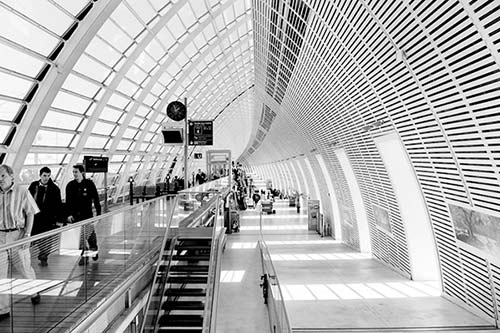
If you’re connecting from the TGV station to other points, you’ll find buses to Arles’ Centre-Ville station at the second bus shelter (€7.50, 9/day, hourly, included with rail pass, schedule posted on shelter and available at TGV station info booths).
If you’re driving, Arles is well-signed from the TGV station. If driving to St-Rémy-de-Provence, Les Baux, or the Luberon, leave the station following signs to Avignon Sud, then La Rocade. You’ll soon see exits to Arles (follow those for St-Rémy and Les Baux) and Cavaillon (for Luberon villages).
The efficient bus station (gare routière) is 100 yards to the right as you exit the Centre-Ville train station, beyond and below Hôtel Ibis (helpful info desk open Mon-Sat 7:00-19:30, closed Sun, tel. 04 90 82 07 35).
Avignon is essentially traffic-free in the old center. There are several safe underground parking lots clearly signposted. For those day-tripping in and wanting the most central garage, follow signs to Centre, then to the Centre Historique and then P Palais des Papes (from where, after parking, you’ll climb the stairs and arrive at the pope’s doorstep, €12 half-day, €20/24 hours).
You can also park for free at the edge of town at lots with complimentary shuttle buses to the center (no shuttles on Sunday; see “Avignon” map).
Follow P Gratuit signs for Parking de l’Ile Piot, across Pont Daladier on Ile de la Barthelasse, with shuttles to Place Crillon; or to Parking des Italiens, along the river east of the Palace of the Popes, with shuttles to Place Pie (allow 30 minutes to walk from either parking lot to the center). Street parking is €1-3/hour for a maximum of four hours Mon-Sat 9:00-19:00 (free 19:00-9:00 and all day Sunday).
No matter where you park, leave nothing of value in your car.
Book Ahead for July: During the July theater festival, rooms are almost impossible to come by—reserve early, or stay in Arles or St-Rémy.
Local Help: David at Imagine Tours, a nonprofit group whose goal is to promote this region, can help with hotel emergencies and special-event tickets (mobile 06 89 22 19 87, www.imagine-tours.net, imagine.tours@gmail.com). If you don’t get an answer, leave a message.
English Bookstore: Try Camili Books & Tea, a secondhand bookshop with a refreshing courtyard and hot drinks (Tue-Sat 12:00-19:00, closed Sun-Mon, free Wi-Fi, 155 Rue Carreterie, in Avignon’s northeast corner—see “Avignon” map).
Baggage Storage: La Consigne will either be in the Centre-Ville train station or a few blocks away under the modern arcade at 1 Avenue Maréchal de Lattre de Tassigny (€6-10/day; June-Aug daily 8:00-21:00; Sept-May Mon-Sat 9:00-18:00, closed Sun, tel. 09 82 45 20 24, www.consigne-avignon.fr).

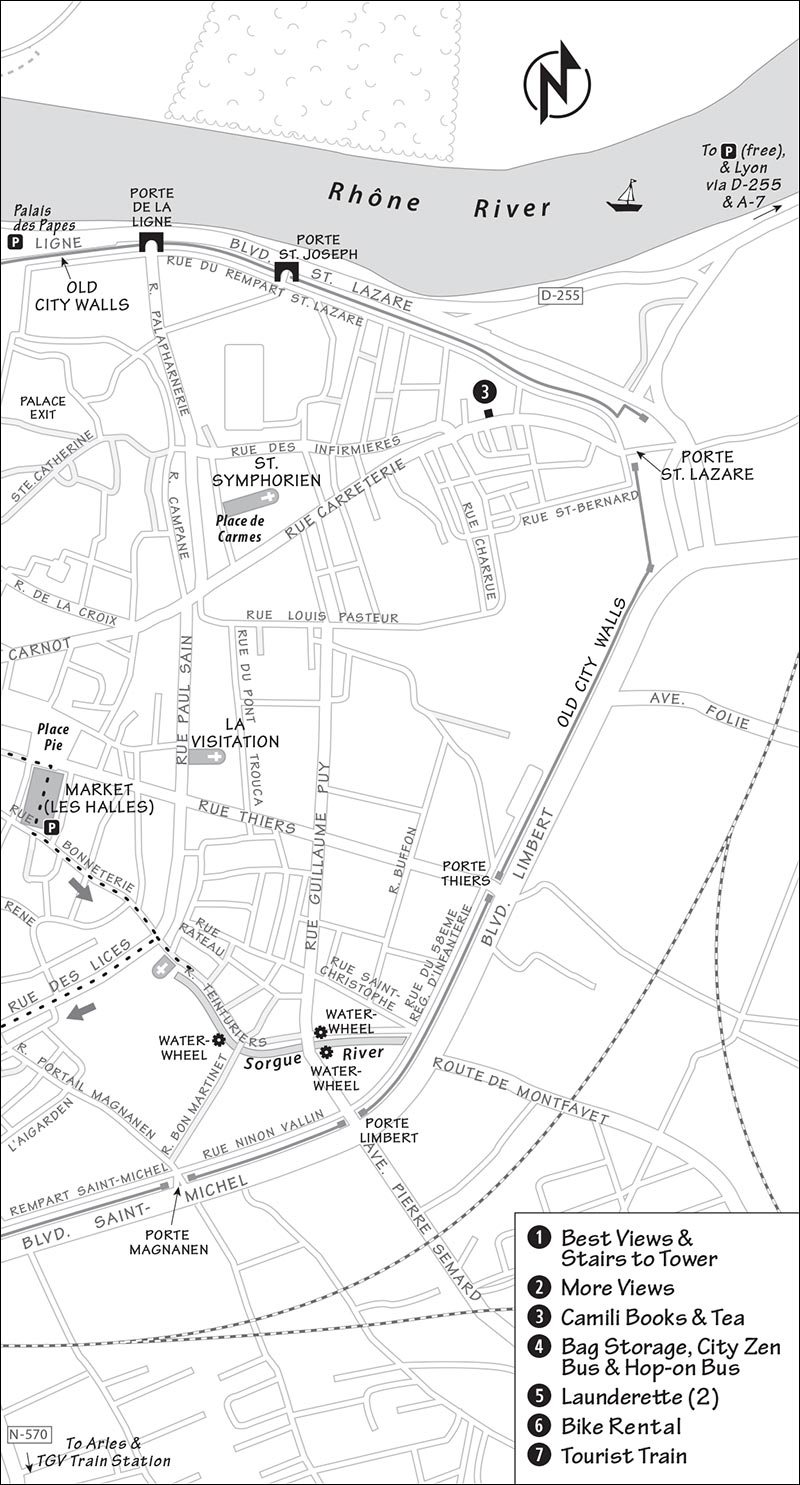
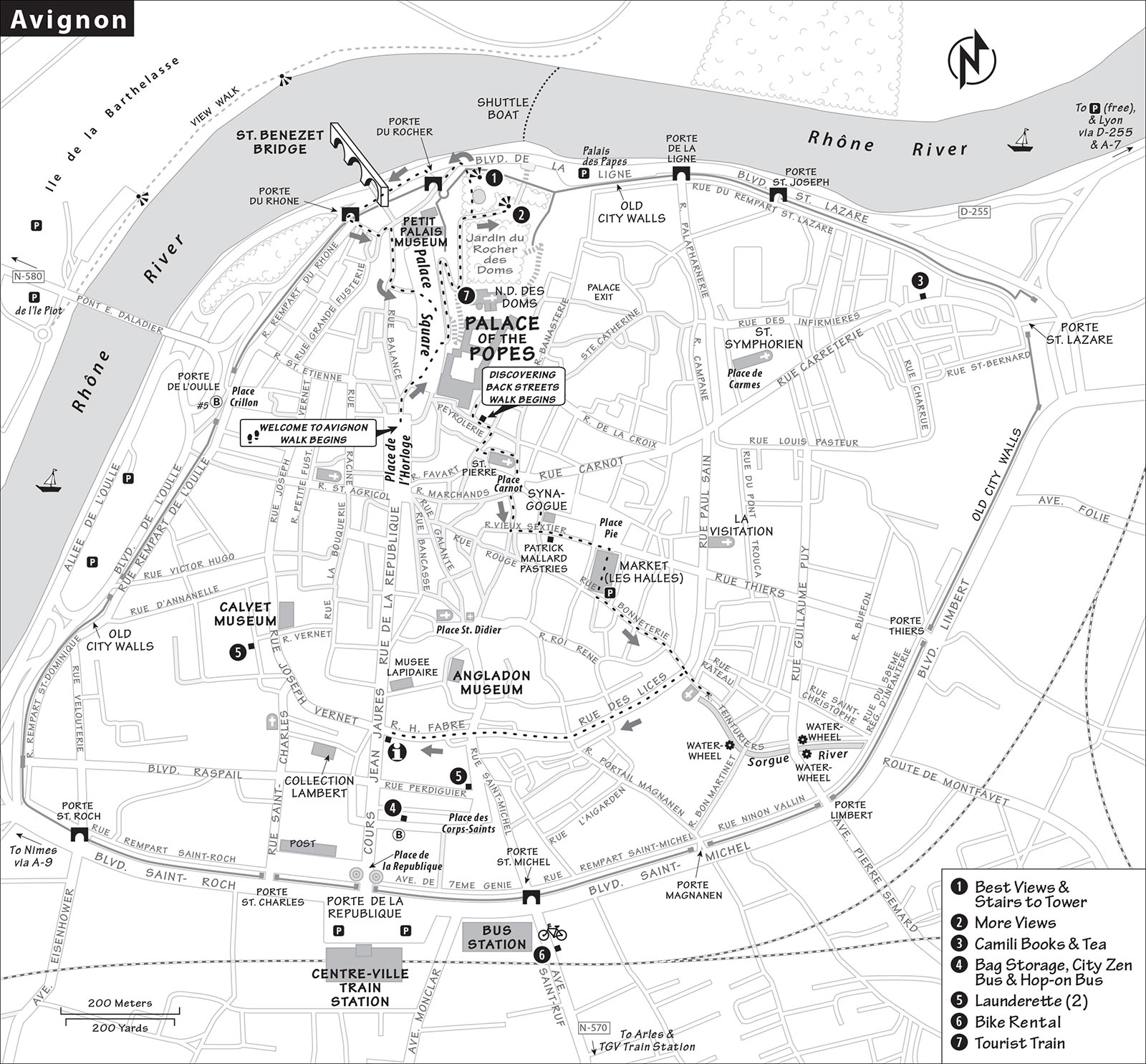
Laundry: At La Blanchisseuse, you can drop off your laundry and pick it up the same day (daily 7:00-21:00, several blocks west of the TI at 24 Rue Lanterne, tel. 04 90 85 58 80). The launderette at 66 Place des Corps-Saints, where Rue Agricol Perdiguier ends, is handy to most hotels (daily 7:00-20:00).
Grocery Store: Carrefour City is central and has long hours daily (2 blocks from TI, toward Place de l’Horloge on Rue de la République). A second Carrefour City is near Les Halles at 19 Rue Florence (same hours). See the “Avignon Hotels & Restaurants” map for locations.
Taxi: Dial 04 90 82 20 20 to get a cab.
Bike Rental: Rent pedal and electric bikes and scooters near the train station at Provence Bike (April-Oct 9:00-18:30, 7 Avenue St. Ruf, tel. 04 90 27 92 61, www.provence-bike.com), or ask at the TI about other options. You’ll enjoy riding on the Ile de la Barthelasse (the TI has bike maps), but biking is better in and around Isle-sur-la-Sorgue and Vaison-la-Romaine.
Car Rental: The TGV station has counters for all the big companies; only Avis is at the Centre-Ville station.
Shuttle Vans: Wave down a Baladine electric minivan along its loop route through Avignon, or use City Zen minibuses with fixed stops (€0.50, 4/hour for either). City Zen minibuses also link remote parking lots with the city center. The TI has route maps.
Shuttle Boat: A free shuttle boat, the Navette Fluviale, plies back and forth across the river (as it did in the days when the town had no functioning bridge) from near St. Bénezet Bridge (3/hour, daily April-June and Sept 10:00-12:15 & 14:00-18:00, July-Aug 11:00-20:45; Oct-March weekends and Wed afternoons only). It drops you on the peaceful Ile de la Barthelasse, with its recommended riverside restaurant, grassy walks, and bike rides with memorable city views. If you stay on the island for dinner, check the schedule for the last return boat—or be prepared for a taxi ride or a 30-minute walk back to town.
Commanding City Views: For great views of Avignon and the river, walk or drive across Daladier Bridge, or ferry across the Rhône on the Navette Fluviale (described above). I’d take the boat across the river, walk the view path to Daladier Bridge, and then cross back over the bridge (45-minute walk). You can enjoy other impressive vistas from the top of the Jardin du Rochers des Doms, from the tower in the Palace of the Popes, from the end of the famous, broken St. Bénezet Bridge, and from the entrance to Fort St. André, across the river in Villeneuve-lès-Avignon.
Isabelle Magny is a good local guide for the city and region (€160/half-day, €330/day, no car, mobile 06 11 82 17 92, isabellemagny@sfr.fr). Nina Seffusatti is also good (same prices as Isabelle, mobile 06 14 80 30 37, nina-seffusatti@wanadoo.fr).
The Avignon Gourmet Walking Tour is a wonderful experience if you like to eat. Charming and passionate Aurélie meets small groups daily (except Sun and Mon) at the TI at 9:00 for a well-designed three-hour, eight-stop walk. Her tour is filled with information and tastes of top-quality local foods and drinks, and finishes in the market hall (€59/person, 2-8 people per group, mobile 06 35 32 08 96, www.avignongourmetours.com). Book in advance on her website.
The little train leaves regularly (generally on the half hour) from in front of the Palace of the Popes and offers a decent overview of the city, including the Jardin du Rochers des Doms and St. Bénezet Bridge (€9, 2/hour, 45 minutes, recorded English commentary, mid-March-Oct daily 10:00-18:00, until 20:00 July-Aug).
Visite Avignon’s open-top double-decker bus does a one-hour loop through the old city, up to the Jardin du Rocher des Doms, crosses the river onto Ile de la Barthelasse, then travels into Villeneuve-les-Avignon, with 18 stops including the Tower of Philip the Fair (€16, hourly departures, main stop between TI and train station on Cours Jean Jaurès, www.visiteavignon.com).
Several minivan tour companies based in Avignon offer transportation to destinations described in this book, including Pont du Gard, the Luberon, and the Camargue (see “Tours in Provence” on here).
For an excellent city overview, combine these two self-guided walks. “Welcome to Avignon” covers the major sights, while “Discovering Avignon’s Back Streets” leads you along the lanes less taken, delving beyond the surface of this historic city. To trace both routes, see the “Avignon” map, earlier in this section.
Start this ▲▲ tour where the Romans did, on Place de l’Horloge, in front of City Hall (Hôtel de Ville).
In ancient Roman times this was the forum, and in medieval times it was the market square. The square is named for the clock tower (now hiding behind the more recently built City Hall) that, in its day, was a humanist statement. In medieval France, the only bells in town rang from the church tower to indicate not the hours but the calls to prayer. With the dawn of the modern age, secular clock towers like this rang out the hours as people organized their lives independent of the Church.
Taking humanism a step further, the City Hall, built after the French Revolution, obstructed the view of the old clock tower while celebrating a new era. The slogan “liberty, equality, and brotherhood” is a reminder that the people supersede the king and the Church. And today, judging from the square’s jammed cafés and restaurants, it is indeed the people who rule.
The square’s present popularity arrived with the trains in 1854. Facing City Hall, look left down the main drag, Rue de la République. When the trains came to Avignon, proud city fathers wanted a direct, impressive way to link the new station to the heart of the city—so they destroyed existing homes to create Rue de la République and widened Place de l’Horloge.
• Walk slightly uphill past the neo-Renaissance facade of the theater and the carousel (public WCs behind). Look back to see the late Gothic bell tower. Then veer right at the Palace of the Popes and continue into...
Pull up a concrete stump just past the café. These bollards effectively keep cars from double-parking in areas designed for people. Many of the metal ones slide up and down by remote control to let privileged cars come and go.
Now take in the scene. This grand square is lined with the Palace of the Popes, the Petit Palais, and the cathedral. In the 1300s the entire headquarters of the Roman Catholic Church was moved to Avignon. The Church purchased the city of Avignon and gave it a complete makeover. Along with clearing out vast spaces like this square and building a three-acre palace, the Church erected more than three miles of protective wall (with 39 towers), “appropriate” housing for cardinals (read: mansions), and residences for its entire bureaucracy. The city was Europe’s largest construction zone. Avignon’s population grew from 6,000 to 25,000 in short order. (Today, only 13,000 people live within the walls.) The limits of pre-papal Avignon are outlined on your city map: Rues Joseph Vernet, Henri Fabre, des Lices, and Philonarde all follow the route of the city’s earlier defensive wall (about half the diameter of today’s wall).
The imposing facade behind you, across the square from the Palace of the Popes’ main entry, was “the papal mint,” which served as the finance department for the Holy See. The Petit Palais (Little Palace) seals the uphill end of the square and was built for a cardinal; today it houses medieval paintings.
Avignon’s 12th-century Romanesque cathedral, just to the left of the Palace of the Popes, has been the seat of the local bishop for more than a thousand years.
• You can visit the massive Palace of the Popes (described later), but it works better to visit that palace at the end of this walk, then continue directly to my “Discovering Avignon’s Back Streets Walk.”
Now is a good time to take in the...
This former cardinal’s palace now displays the Church’s collection of (mostly) art. You’ll find some English information but not a lot of detail. Still, a visit here before going to the Palace of the Popes helps furnish and populate that otherwise barren building. You’ll see bits of statues and tombs—an inventory of the destruction of exquisite Church art that was wrought by the French Revolution (which tackled established French society with Taliban-esque fervor). Then you’ll see many rooms filled with religious Italian paintings, organized in chronological order from early Gothic to late Renaissance. Room 10 holds two paintings by Botticelli.
Cost and Hours: Free, Wed-Mon 10:00-13:00 & 14:00-18:00, closed Tue, ask about summer sound-and-light shows in main courtyard, at north end of Palace Square, tel. 04 90 86 44 58, www.petit-palais.org.
• From Palace Square, head up to the cathedral (enjoy the viewpoint overlooking the square from its front porch), and fill your water bottle just past the gate. Now climb the ramp to the top of a rocky hill, passing “the popes’ vineyard,” to where Avignon was first settled. Atop the hill is an inviting café and pond in a park—the Jardin du Rocher des Doms. At the far side (the top end with the green suicide-prevention fence) is a viewpoint high above the river from where you can see Avignon’s beloved broken bridge.
Enjoy the view from this bluff. On a clear day, the tallest peak you see (far to the right), with its white limestone cap, is Mont Ventoux (“Windy Mountain”). Below and just to the right, you’ll spot free passenger ferries shuttling across the river, and—tucked amidst the trees on the far side of the river—the recommended restaurant, Le Bercail, a local favorite. The island in the river is the Ile de la Barthelasse, a lush nature preserve where Avignon can breathe. In the distance to the left is the TGV rail bridge.

Medieval Avignon was administered by the Vatican and independent of the rest of France. The Rhône River marked the border of Vatican territory in medieval times. Fort St. André—across the river on the hill—was in the kingdom of France. The fort was built in 1360, shortly after the pope moved to Avignon, to counter the papal incursion into this part of Europe. Avignon’s famous bridge was a key border crossing, with towers on either end—one was French, and the other was the pope’s. The French one, across the river, is the Tower of Philip the Fair (described later, under “More Sights in Avignon”).
Cost and Hours: Free, park gates open daily 7:30-20:00, June-Aug until 21:00, Oct-March until 18:00.
• Take the walkway down to the left (passing the popes’ vineyard again) and find the stairs leading down to the tower. You’ll catch glimpses of the...
The only bit of the rampart you can walk on is accessed from St. Bénezet Bridge (accessible only with your ticket to the bridge). Just after the papacy took control of Avignon, the walls were extended to take in the convents and monasteries that had been outside the city. What you see today was partially restored in the 19th century.
• When you come out of the tower on street level, turn left to walk inside the city wall to the entry to the old bridge.
This bridge, whose construction and location were inspired by a shepherd’s religious vision, is the “Pont d’Avignon” of nursery-rhyme fame. The ditty (which you’ve probably been humming all day) dates back to the 15th century: Sur le Pont d’Avignon, on y danse, on y danse, sur le Pont d’Avignon, on y danse tous en rond (“On the bridge of Avignon, we will dance, we will dance, on the bridge of Avignon, we will dance all in a circle”).
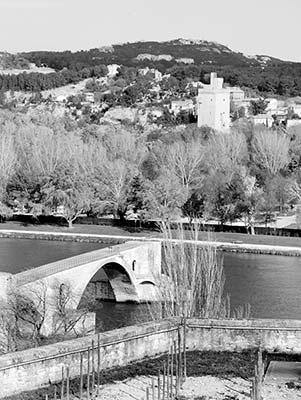
And the bridge was a big deal even outside its kiddie-tune fame. Built between 1171 and 1185, it was strategic—one of only three bridges crossing the mighty Rhône in the Middle Ages, important to pilgrims, merchants, and armies. It was damaged several times by floods but always rebuilt. In the winter of 1668 most of it was knocked out for the last time by a disastrous icy flood. The townsfolk decided not to rebuild this time, and for more than a century, Avignon had no bridge across the Rhône. While only four arches survive today, the original bridge was huge: Imagine a 22-arch, half-mile-long bridge extending from Vatican territory across the island to the lonely Tower of Philip the Fair, which marked the beginning of France (see displays of the bridge’s original length).
Cost and Hours: €5, includes audioguide, €14.50 combo-ticket includes Palace of the Popes, daily 9:00-19:00, July-Aug until 20:00, Nov-Feb 9:30-17:45, last entry one hour before closing, tel. 04 90 27 51 16.
• To get to the Palace of the Popes from here, walk away from the river and follow the signs to Palais des Papes.
In 1309 a French pope was elected (Pope Clément V). His Holiness decided that dangerous Italy was no place for a pope, so he moved the whole operation to Avignon for a secure rule under a supportive French king. The Catholic Church literally bought Avignon (then a two-bit town) and built the Palace of the Popes, where the popes resided until 1403. Eventually, Italians demanded a Roman pope, so from 1378 on, there were twin popes—one in Rome and one in Avignon—causing a schism in the Catholic Church that wasn’t fully resolved until 1417.
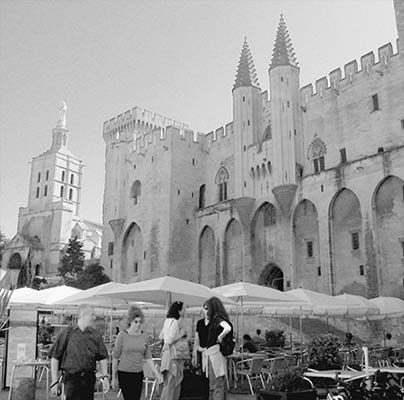
Cost and Hours: €12, includes multimedia Histopad; €14.50 combo-ticket includes St. Bénezet Bridge, daily 9:00-19:00, July-Aug until 20:00, Nov-Feb 9:30-17:45, last entry one hour before closing; tel. 04 90 27 50 00, www.palais-des-papes.com.
Visiting the Palace: Visitors follow a tangled one-way route through mostly massive rooms equipped with an iPad they call “The Histopad”—an earnest effort to bring these old papal spaces to life. There’s a lot of history here, but artifacts are sparse and wall frescos are faint: Without guiding help, it’s mostly meaningless. Old-fashioned English-language boards in each room provide a little info, but your visit becomes greatly enriched if you master the included Histopad—the staff is happy to help you with it. Nine posts during the tour activate a time-tunnel effect, taking you back to the 14th century as you furnish the rooms by pointing your iPad. While in this mode, you can click on various points in the room for more info.
The palace was built stark and strong, before the popes knew how long they’d be staying (and before the affluence and fanciness of the Renaissance and Baroque ages). This was the most fortified palace of the time (remember, the pope left Rome to be more secure). With 10-foot-thick walls, it was a symbol of power.
This largest surviving Gothic palace in Europe was built to accommodate 500 people as the administrative center of the Holy See and home of the pope. Seven popes ruled from here, making this the center of Christianity for nearly 100 years. The last pope checked out in 1403, but the Church owned Avignon until the French Revolution in 1791. During this interim period, the palace still housed Church authorities. Avignon residents, many of whom had come from Rome, spoke Italian for a century after the pope left, making the town a cultural oddity within France.
The palace is pretty empty today—nothing portable survived both the pope’s return to Rome and the French Revolution. Just before the gift shop exit, you can climb the tower (Tour de la Gâche) for grand views. The artillery room is now a gift shop channeling all visitors on a full tour of knickknacks for sale.
• You’ll exit at the rear of the palace, where my next walk, “Discovering Avignon’s Back Streets,” begins. Or, to return to Palace Square, make two rights after exiting the palace.
Use the map earlier in this section to navigate this easy, level, 30-minute walk, worth ▲▲. We’ll begin in the small square (Place de la Mirande) behind the Palace of the Popes. If you’ve toured the palace, this is where you exit. Otherwise, from the front of the palace, follow the narrow, cobbled Rue de la Peyrolerie—carved out of the rock—around the palace on the right side as you face it.
• Our walk begins at the...
Hôtel La Mirande: Avignon’s finest hotel welcomes visitors. Find the atrium lounge, check out the queenly garden, and consider a coffee break amid the understated luxury (€12 afternoon tea served daily 15:00-18:00, see listing under “Eating in Avignon,” later).
• Turn left out of the hotel and left again on Rue de la Peyrolerie (“Coppersmiths Street”), then take your first right on Rue des Ciseaux d’Or (“Street of the Golden Scissors”). On the small square ahead you’ll find the...
Church of St. Pierre: The original walnut doors were carved in 1551, when tales of New World discoveries raced across Europe. (Notice the Indian headdress, top center of left-side door.) The fine Annunciation (eye level on right-side door) shows Gabriel giving Mary the exciting news in impressive Renaissance 3-D. The niches on the facade are empty except for one mismatched Mary and Child filling the center niche. (The original was ransacked by the Revolution.) Now take 10 steps back from the door and look way up. The tiny statue breaking the skyline of the church is a tiny, naked baby—that’s Bacchus, the pagan god of wine, with oodles of grapes. What’s he doing sitting atop a Christian church? No one knows. The church’s interior—with its art amped up as a Counter-Reformation answer to the Protestant threat—holds a beautiful Baroque altar.
• Facing the church door, turn left and pass the recommended L’Epicerie restaurant, then follow the alley, which was covered and turned into a tunnel during the town’s population boom. It leads into...
Place des Châtaignes: The cloister of St. Pierre is named for the chestnut (châtaigne) trees that once stood here (now replaced by plane trees). The practical atheists of the French Revolution destroyed the cloister, leaving only faint traces of the arches along the church side of the square.
• Continue around the church and cross the busy street. At the start of little Rue des Fourbisseurs at the right corner, find the big...
15th-Century Building: With its original beamed eaves showing, this is a rare vestige from the Middle Ages. Notice how this building widens the higher it gets. A medieval loophole based taxes on ground-floor square footage—everything above was tax-free. Walking down Rue des Fourbisseurs (“Street of the Animal Furriers”), notice how the top floors almost touch. Fire was a constant danger in the Middle Ages, as flames leapt easily from one home to the next. In fact, the lookout guard’s primary responsibility was watching for fires, not the enemy. Because of fires, this is the only 15th-century home surviving in town. After this period, buildings were made of fire-resistant stone, like those across the street.
• Walk down Rue des Fourbisseurs past lots of shops and turn left onto the traffic-free Rue du Vieux Sextier (“Street of the Old Sexy People”); another left under the first arch leads in 10 yards to one of France’s oldest synagogues.
Synagogue: Jews first arrived in Avignon with the Diaspora (exile after the Romans destroyed their great temple) in the first century. Avignon’s Jews were nicknamed “the Pope’s Jews” because of the protection that the Church offered to Jews expelled from France. Although the original synagogue dates from the 1220s, in the mid-19th century it was completely rebuilt in a Neoclassical Greek-temple style by a non-Jewish architect. This is the only synagogue under a rotunda. It’s an intimate, classy place—where a community of 500 local Jews worships—dressed with white colonnades and walnut furnishings (free, Mon-Fri 9:00-11:00, ring doorbell at #6, closed Sat-Sun and holidays, 2 Place Jerusalem).
• Retrace your steps to Rue du Vieux Sextier and turn left. A few steps down the street (on the right) is Patrick Mallard—an inviting pastry shop. It’s one of two shops authorized to sell Avignon’s one-of-a-kind, thistle-shaped candy called papalines d’Avignon (dark chocolate wrapped in pink-hued chocolate and filled with a liquor made from local plants).
Continue down Rue du Vieux Sextier to the big square (across the busy street) and find the big, boxy market building with the vertical (hydroponic) garden growing out its front wall.
Market (Les Halles): In 1970, the town’s open-air market was replaced by this modern one (more efficient, with a parking garage overhead, hoping to compete with supermarkets in the suburbs). The market’s jungle-like hydroponic green wall reflects the changes of seasons and helps mitigate its otherwise stark exterior (Tue-Sun until 13:00, closed Mon). Step inside for a sensual experience of organic breads, olives, and festival-of-mold cheeses. Cheap cafés, bars, and good cheese shops are mostly on the right—the stinky fish stalls are on the left. This is a terrific place for lunch (doors close weekdays at 13:30, Sat-Sun at 14:00)—especially if you’d fancy a big plate of mixed seafood with a glass of white wine (see “Eating in Avignon,” later, for several good lunch options).
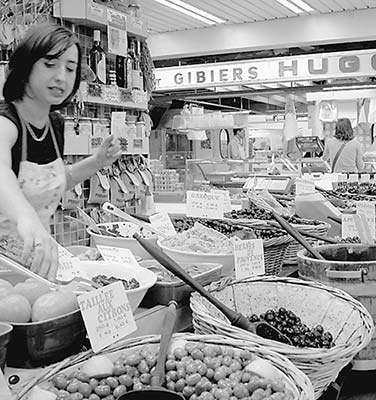
• Walk through the market and exit out the back door, then turn left on Rue de la Bonneterie (“Street of Hosiery”), which has recently transitioned from a busy street for cars to a more peaceful—and therefore more prosperous—pedestrian zone lined with triple-A shops (alternative, arty, and artisan). Track the street for five minutes to the plane trees, where it becomes...
Rue des Teinturiers: This “Street of the Dyers” is a bohemian-friendly, tree- and stream-lined lane, home to earthy cafés and galleries. This was the cloth industry’s dyeing and textile center in the 1800s. The stream is a branch of the Sorgue River. Those stylish Provençal fabrics and patterns you see for sale everywhere were first made here, based on printed fabrics originally imported from India.
About three small bridges down, you’ll pass the Grey Penitents chapel on the right. The upper facade shows the GPs, who dressed up in robes and pointy hoods to do their anonymous good deeds back in the 13th century. (While the American KKK dresses in hoods to hide their hateful racism, these hoods symbolized how all are equal in God’s eyes.) As you stroll on, you’ll see the work of amateur sculptors, who have carved whimsical car barriers out of limestone. Fun restaurants on this atmospheric street are recommended later, under “Eating in Avignon.”
• Farther down Rue des Teinturiers, you’ll come to the...
Waterwheel: Standing here, imagine the Sorgue River—which hits the mighty Rhône in Avignon—being broken into several canals in order to turn 23 such wheels. Starting in about 1800, waterwheels powered the town’s industries. The little cogwheel above the big one could be shoved into place, kicking another machine into gear behind the wall.
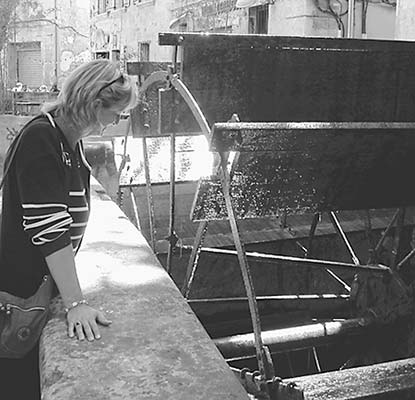
• If you’re ready for a meal or drinks in the Rue des Teinturiers quarter, see “Eating in Avignon,” later. To return to the center of town, double back on Rue des Teinturiers and turn left on Rue des Lices, which traces the first medieval wall. (A “lice” is the no-man’s-land along a protective wall.) After a long block you’ll pass a striking four-story building that was a home for the poor in the 1600s, an army barracks in the 1800s, a fine-arts school in the 1900s, and is a deluxe condominium today (much of this neighborhood is going high-class residential). Eventually you’ll return to Rue de la République, Avignon’s main drag.
Most of Avignon’s top sights are covered earlier by my self-guided walks. With more time, consider these options.
Visiting this museum is like being invited into the elegant home of a rich and passionate art collector. It houses a small but enjoyable collection of art from Post-Impressionists to Cubists (including Paul Cézanne, Vincent van Gogh, Edgar Degas, and Pablo Picasso), with re-created art studios and furnishings from many periods. It’s a quiet place with a few superb paintings and good temporary exhibits.
Cost and Hours: €8, Tue-Sun 13:00-18:00, closed Mon, 5 Rue Laboureur, tel. 04 90 82 29 03, www.angladon.com.
This fine-arts museum, ignored by most, impressively displays a collection highlighting French Baroque works and Northern masters such as Hieronymus Bosch and Pieter Bruegel. You’ll find a few gems upstairs: a painting each by Manet, Sisley, Géricault, and David. On the ground floor is a room dedicated to more modern artists, with works by Soutine, Bonnard, and Vlamnick. The Calvet Museum’s antiquities collection, Le Musée Lapidaire, is hosted in a church a few blocks away at 27 Rue de la République.
Cost and Hours: Free, includes audioguide and Le Musée Lapidaire, Wed-Mon 10:00-13:00 & 14:00-18:00, closed Tue, in the western half of town at 65 Rue Joseph Vernet, tel. 04 90 86 33 84, www.musee-calvet.org.
This modern art museum, situated in a grand 18th-century mansion, features works from the 1960s to the present. It came from the famous art dealer Yvon Lambert, who was determined to make well-known contemporary art accessible outside Paris. The recommended Le Violette restaurant in the courtyard is worth the visit alone.
Cost and Hours: €10, Tue-Sun 11:00-18:00, closed Mon except July-Aug when it’s open until 19:00, 5 Rue Violette, tel. 04 90 16 56 20, www.collectionlambert.fr.
Built to protect access to St. Bénezet Bridge in 1307, this hulking tower, located in nearby Villeneuve-lès-Avignon, offers a terrific view over Avignon and the Rhône basin.
Cost and Hours: €2.50; Tue-Sun 10:00-12:30 & 14:00-18:00, Feb-April and Nov 14:00-17:00 only, closed Dec-Jan and Mon year-round.
Getting There: To reach the tower from Avignon, drive five minutes (cross Daladier Bridge, follow signs to Villeneuve-lès-Avignon), or take bus #5 (2/hour, bus stops just outside Place du Crillon, see the “Avignon” map).
Hotel values are better in Arles. Avignon is crazy during its July festival—you must book long ahead and pay inflated prices. Drivers should ask about parking discounts through hotels.
These listings are a 5- to 10-minute walk from the Centre-Ville train station.
$$ Hôtel Bristol** is a big, professionally run place on the main drag, offering predictable “American” comforts at fair rates. Enjoy spacious public spaces, large rooms, big elevators, and a generous buffet breakfast (family rooms, pay parking—reserve ahead, 44 Cours Jean Jaurès, tel. 04 90 16 48 48, www.bristol-avignon.com, contact@bristol-avignon.com).
$ Hôtel Ibis Centre Gare*** offers tight-but-tasteful comfort and quiet near the central train and bus stations (42 Boulevard St. Roch, tel. 04 90 85 38 38, www.ibishotel.com, h0944@accor.com).
$ Hôtel Colbert** is on a quiet lane, with a dozen spacious rooms gathered on four floors around a skinny spiral staircase (no elevator). Patrice decorates each room as if it were his own, with a colorful (occasionally erotic) flair. There are warm public spaces and a sweet little patio (some tight bathrooms, rooms off the patio can be musty, closed Nov-March, 7 Rue Agricol Perdiguier, tel. 04 90 86 20 20, www.lecolbert-hotel.com, contact@avignon-hotel-colbert.com).
$ At Hôtel Boquier,** helpful owner Frédéric offers 13 quiet, good-value, and homey rooms under wood beams in a central location (family rooms, steep and narrow stairways to some rooms, no elevator, pay parking nearby, near the TI at 6 Rue du Portail Boquier, tel. 04 90 82 34 43, www.hotel-boquier.com, contact@hotel-boquier.com).
¢ Hôtel les Corps Saints,** run by young Agnes and Fabrice, rents 16 bright rooms with tight baths at fair rates (no elevator, 17 Rue Agricol Perdiguier, tel. 04 90 86 14 46, www.hotel-les-corps-saints.fr, corpssaints.avignon@gmail.com).
$$$$ Hôtel d’Europe,***** one of Avignon’s most prestigious addresses, lets peasants sleep affordably—but only if they land one of the six reasonable “classique” rooms. With formal staff, spacious lounges, and a shady courtyard, the hotel is located on the handsome Place Crillon, near the river (pay garage parking, near Daladier Bridge at 12 Place Crillon, tel. 04 90 14 76 76, www.heurope.com, reservations@heurope.com). Readers seeking top comfort should compare this hotel with Hôtel la Mirande, next.
$$$$ Hôtel la Mirande***** pampers its guests with traditional luxury in a quiet, central location behind the Palace of the Popes. The welcoming staff delivers service with a smile, public spaces are comfy and welcoming, and the rooms are exquisitely decorated. The hotel also houses a well-respected restaurant (4 Place de l’Amirande, tel. 04 90 14 20 20, www.la-mirande.fr).
$$$ Hôtel de l’Horloge**** is as central as it gets—on Place de l’Horloge. It offers 66 comfortable rooms, some with terraces and views of the city and the Palace of the Popes (1 Rue Félicien David, tel. 04 90 16 42 00, www.hotel-avignon-horloge.com, hotel.horloge@hotels-ocre-azur.com).
$$$ Hôtel Mercure Palais des Papes,**** about a block from the Palace of the Popes, has a modern exterior and 86 big, smartly designed rooms, many with small balconies (about half the rooms have views over Place de l’Horloge, others are quieter with views over the Palace of the Popes, 1 Rue Jean Vilar, tel. 04 90 80 93 00, www.mercure.com, h1952@accor.com).
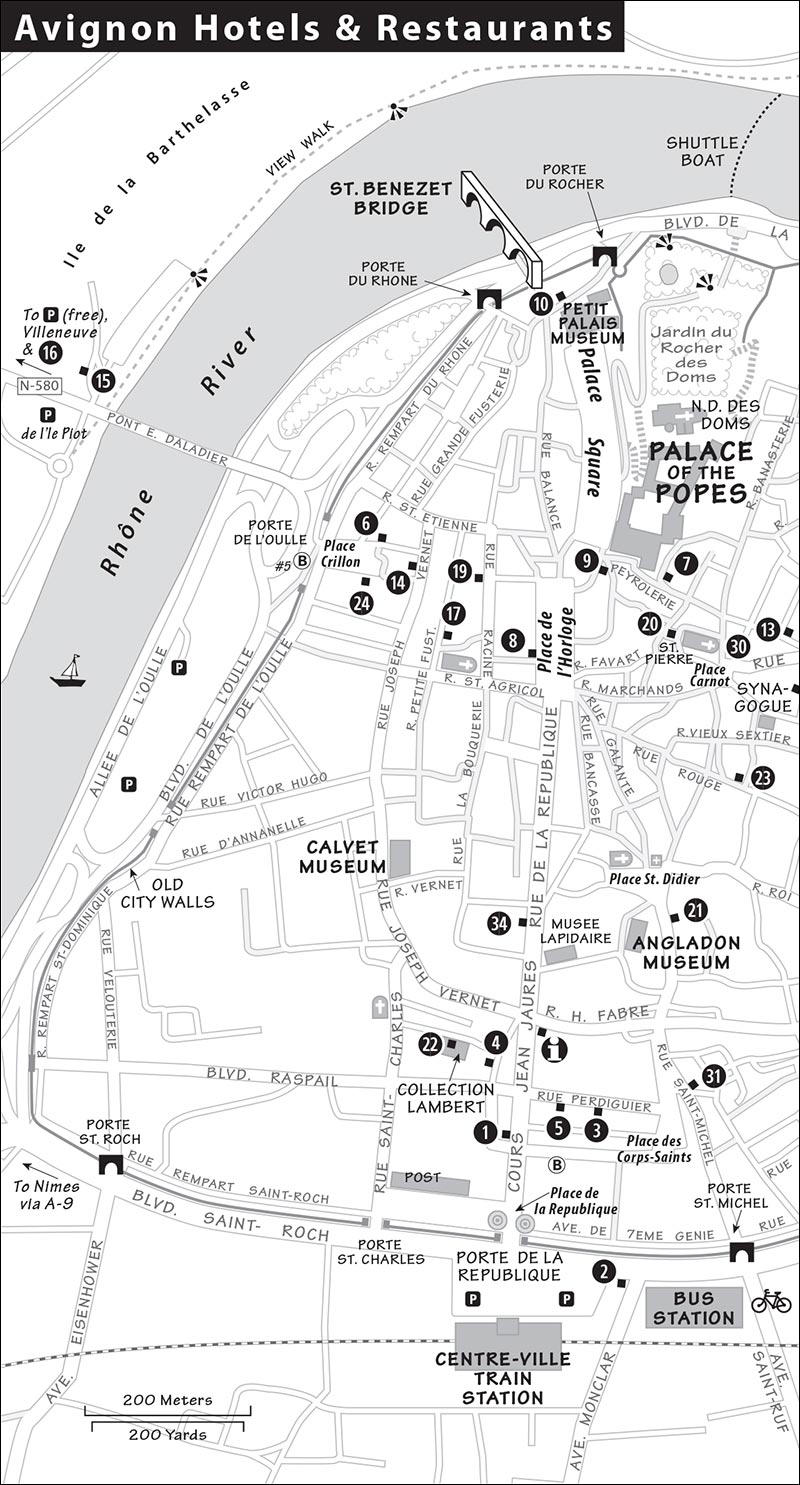

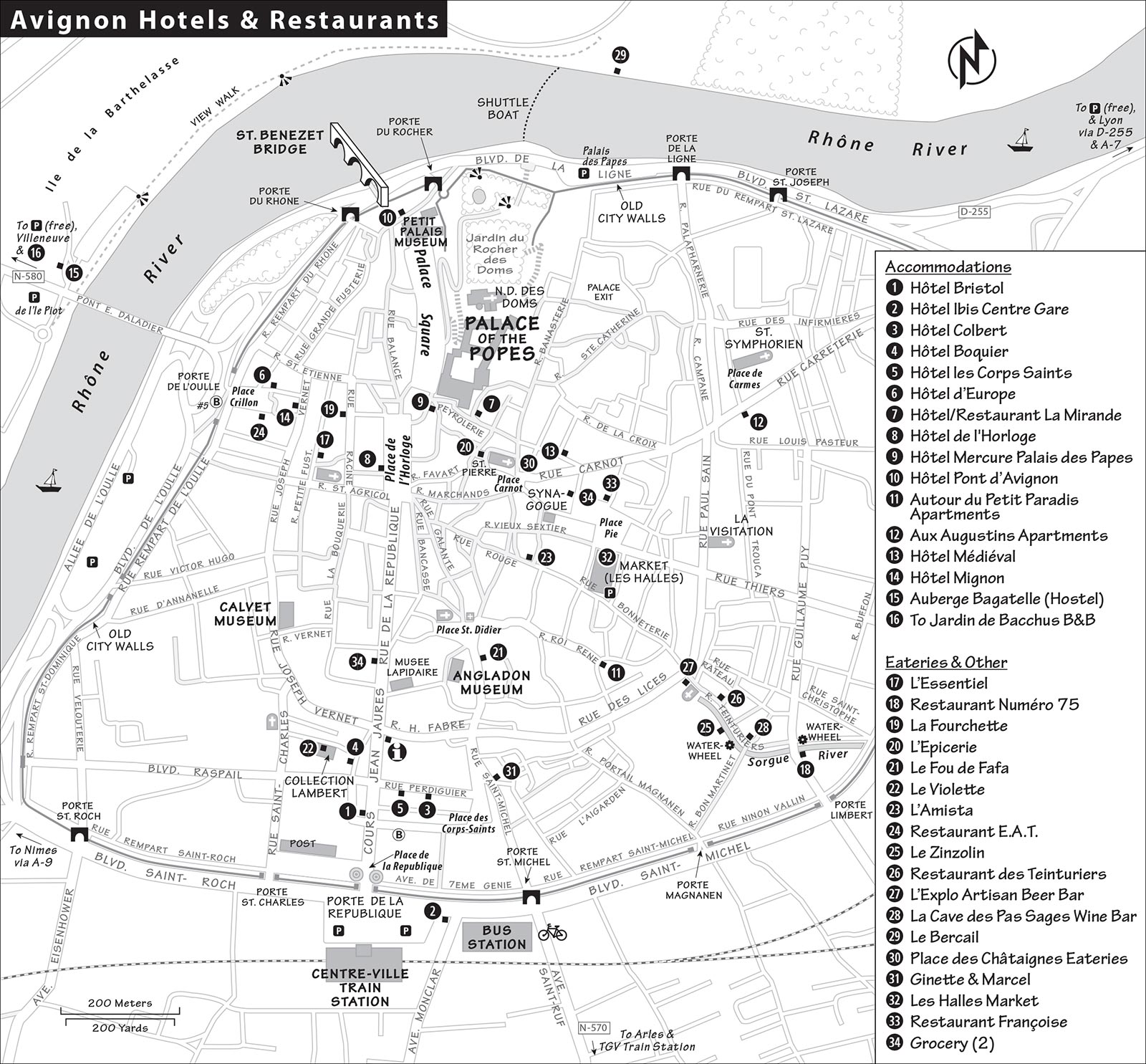
$$$ Hôtel Pont d’Avignon,**** just inside the walls near St. Bénezet Bridge, is part of the same chain as Hôtel Mercure Palais des Papes, with the same prices for its 87 rooms. There’s an airy atrium breakfast room and small garden terrace (direct access to a garage makes parking easier than at the other Mercure hotel, parking deals, on Rue Ferruce, tel. 04 90 80 93 93, www.mercure.com, h0549@accor.com).
$$ Autour du Petit Paradis Apartments and Aux Augustins, run by Sabine and Patrick, offer 22 contemporary, well-furnished rooms and studios with kitchenettes spread over two locations. Autour du Petit Paradis, in a restored 17th-century mansion, is central and plenty comfortable (5 Rue Noël Biret, tel. 04 90 81 00 42); Augustins is less central with larger rooms and a nicer courtyard with lovely stonework dating from its time as a medieval monastery (16 Rue Carreterie, tel. 04 84 51 01 44). Either place will pick you up at the TGV station for a fee, and neither has an elevator (www.autourdupetitparadis.com, contact@autourdupetitparadis.com).
$ Hôtel Médiéval,** burrowed deep in the old center a few blocks from the Church of St. Pierre, was built as a cardinal’s home. This stone mansion’s grand staircase leads to 35 comfortable, pastel rooms (no elevator, kitchenettes, 5 blocks east of Place de l’Horloge, behind Church of St. Pierre at 15 Rue Petite Saunerie, tel. 04 90 86 11 06, www.hotelmedieval.com, hotel.medieval@wanadoo.fr, run by Régis).
¢ Hôtel Mignon* is a sleepable, homey one-star place with tiny bathrooms (no elevator, 12 Rue Joseph Vernet, tel. 04 90 82 17 30, www.hotel-mignon.com, reservation@hotel-mignon.fr).
Auberge Bagatelle offers dirt-cheap beds in two buildings—a $ budget hotel and a ¢ youth hostel—and has a young and lively vibe, café, grocery store, launderette, great views of Avignon, and campers for neighbors (cheaper rooms with shared bath, family rooms, across Daladier Bridge on Ile de la Barthelasse, bus #5, tel. 04 90 86 30 39, www.hostelworld.com, auberge.bagatelle@wanadoo.fr).
$$ At Jardin de Bacchus, a 15-minute drive northwest of Avignon by car and convenient to Pont du Gard, English-speaking Christine and Erik offer two double rooms (and a couple of apartments) in their village home overlooking the famous rosé vineyards of Tavel (includes breakfast, good €30 dinner if booked in advance, swimming pool, great patio, possible bike rentals, mobile 06 74 41 77 94, www.jardindebacchus.fr, jardindebacchus@gmail.com). By car, it’s just off the A-9 autoroute (exit 22).
Avignon offers a good range of restaurants and settings, from lively squares to atmospheric streets. Skip the crowd-pleasing places on Place de l’Horloge and enjoy better value and atmosphere elsewhere. Avignon is brimming with delightful squares and back streets lined with little restaurants eager to feed you. At the finer places, reservations are generally smart (especially on weekends); your hotel can call for you.
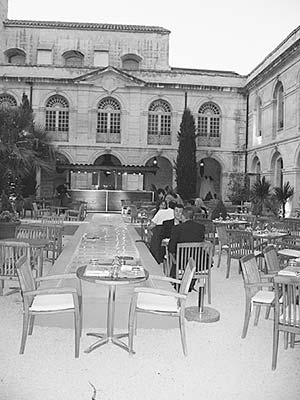
(See “Avignon Hotels & Restaurants” map.)
$$$$ La Mirande, inside the recommended five-star hotel just behind the Pope’s Palace, transports you into a historic and aristocratic world. What was once a cardinal’s palace today is a romantic oasis where you’ll dine in 18th-century splendor with elegant service and presentation. Dress as nicely as you can (dine inside or in the queenly garden, closed Tue-Wed, €50 plats, enticing five-course €65 menu must be ordered by everyone in your party, 4 Place de l’Amirande, tel. 04 90 14 20 20, www.la-mirande.fr).
$$$ L’Essentiel is modern, spacious, and bright, with traditional French dishes. It has classy presentation and ambience, and seating indoors or outdoors on a romantic back terrace (€36-48 menus, closed Sun-Mon, reservations recommended, 2 Rue Petite Fusterie, tel. 04 90 85 87 12, www.restaurantlessentiel.com).
$$$ Restaurant Numéro 75 fills the well-worn Pernod mansion (of pastis liquor fame) with a romantic, chandeliered, Old World dining hall that extends to a leafy, gravelly courtyard. They serve delightful lunch salads, fish is a forte, and the French cuisine is beautifully presented (Mon-Sat 12:00-14:00 & 19:30-22:00, closed Sun, 75 Rue Guillaume Puy, tel. 04 90 27 16 00, www.numero75.com).
$$$ La Fourchette is an inviting, dressy place graced with warm colors and spacious indoor-only seating. The cuisine mixes traditional French with Provençal. Book ahead for this popular place (closed Sun-Mon, 17 Rue Racine, tel. 04 90 85 20 93, www.la-fourchette.net).
(See “Avignon Hotels & Restaurants” map.)
$$$ L’Epicerie sits alone under green awnings on the romantic Place St-Pierre square and is ideal for dinner outside (or in the small but cozy interior). It has an accessible menu with Mediterranean dishes and big, splittable assiettes (sample plates), each with a theme (daily, 10 Place St-Pierre, tel. 04 90 82 74 22, Magda speaks English).
$$$ Le Fou de Fafa is a warm, spacious, 12-table place where delightful Antonia serves while her husband cooks (inside dining only, book ahead or arrive early, Tue-Sat from 18:30, closed Sun-Mon, 17 Rue des Trois Faucons, tel. 04 32 76 35 13).
$$ Le Violette, in the peaceful courtyard of the Collection Lambert modern art museum, serves fresh modern cuisine and is gorgeous when lit by the museum rooms at night (July-Aug daily, Sept-June closed Sun and Mon, 5 Rue Violette, tel. 04 90 85 36 42).
$$ L’Amista (“the spot to meet friends”) is a cozy, youthful, and welcoming place on a quiet lane with indoor and outdoor seating. Run by Delphine, it offers a fun Provençal/Spanish-inspired menu that always includes vegetarian options. Tapas-style plates are great for sharing (daily 12:00-15:00 & 18:30-22:00, closed Sun-Mon off-season, 23 Rue Bonneterie, tel. 09 86 19 36 86).
$$ Restaurant E.A.T., whose name stands for “Estaminet, Arômes et Tentations” (a small restaurant with aroma and temptations), is just off Place du Crillon. It’s locally popular, serving eclectic and fun options with international twists (closed Wed, reservations recommended, 8 Rue Mazan, tel. 04 90 83 46 74, www.restaurant-eat.com).
(See “Avignon Hotels & Restaurants” map.)
Rue des Teinturiers’ fun concentration of midrange, popular-with-the-locals eateries justifies the long walk on a balmy evening. (In bad weather, it’s dead.) It’s a trendy, youthful area, spiffed up but with little hint of tourism. You’ll find wine bars, vegetarian options, and live music at rickety metal tables under shady trees along the canal. I’d walk the street’s entire length to find the best ambience before making a choice. Note that the finer Restaurant Numéro 75, listed earlier, is just around the corner.
$$ Le Zinzolin is a big bohemian diner serving European cuisine with a few vegetarian options, including lots of salads in the summer. The atmosphere is good inside and out (daily, 22 Rue des Teinturiers, tel. 04 90 82 41 55).
$$$ Restaurant des Teinturiers, run by chef Guillaume, combines a casual setting with upscale nouvelle French cuisine and presentation. Guests leave comments on the chalkboard about their “semi-gastronomic meals” (closed Wed and Sun, reservations smart, near the waterwheel at 5 Rue des Teinturiers, tel. 04 90 33 43 83, www.restaurantdesteinturiers.com).
Drinks in the Rue des Teinturiers Quarter: For a break from sightseeing or a relaxing night spot for a drink, this pedestrian-only street has two particularly good watering holes: a craft beer place at the start and a laid-back hippie wine bar at the lazy waterwheel. L’Explo Artisan Beer Bar is like a beer-lovers club on a canal. It’s mod, minimal, and cheap, with a convivial terrace. They serve 10 craft beers (no bottles) all on tap, and sausage and cheese plates to help soak it up (closed Sun-Mon, 2 Rue des Teinturiers, tel. 04 90 31 06 35). La Cave des Pas Sages, a down-and-dirty wine bar, is just right to linger with the locals over a cheap glass of regional wine or beer. Choose from the blackboard by the bar that lists all the open bottles, then join the gang outside by the canal (Mon-Sat 12:00-24:00, closed Sun, 41 Rue des Teinturiers, tel. 04 32 74 25 86).
(See “Avignon Hotels & Restaurants” map.)
$$$ Le Bercail offers a fun opportunity to cross the river, get out of town, and take in the country air with a terrific riverfront view of Avignon, all while enjoying big portions of Provençal cooking. Make a reservation before trekking out there (daily May-Oct, often closed off-season, tel. 04 90 82 20 22, www.restaurant-lebercail.fr). Take the free shuttle boat (located near St. Bénezet Bridge) to the Ile de la Barthelasse, turn right, and walk five minutes. As the boat usually stops running at about 18:00 (20:45 in July-Aug), you can either taxi back or walk 25 minutes along the pleasant riverside path and over Daladier Bridge.
(See “Avignon Hotels & Restaurants” map.)
This “square of the chestnut trees” (technically Place du Cloître Saint-Pierre) offers cheap meals and a fun commotion of tables.
$ La Pause Gourmande, a tiny bakery/deli with the best tables on the square, is great for salads, sandwiches, and daily plats (great fougasse; Mon-Sat 6:00-20:00, closed Sun, tel. 04 90 86 10 84).
$ Crêperie La Flourdiliz is a cheery, traditional Breton place with an open kitchen, a classy-for-a-crêperie interior, and great seating on the square (closed Sun-Mon, tel. 04 90 22 28 14).
$ La Cantine is a convenient place popular for its self-serve, pay-by-weight, cafeteria line (Tue-Sat 11:00-16:00, closed Sun-Mon, a few steps away at 6 Rue Armand de Pontmartin, tel. 09 72 88 67 44).
(See “Avignon Hotels & Restaurants” map.)
This welcoming square offers the best feeling of a neighborhood dining, drinking, and simply living outdoors together. It’s great for outdoor dining in Avignon, with several eateries in all price ranges sharing the same great setting under big plane trees. Survey the scene: tables crammed into every nook and cranny, standard café fare, Italian options, a pizza joint, a wine bar, and finer dining choices. $ Ginette & Marcel: Bistrot à Tartines serves salads, big slices of toast with a variety of toppings, and has tasty desserts (daily 11:00-late, tel. 04 90 85 58 70).
(See “Avignon Hotels & Restaurants” map.)
Avignon’s youth make their home on Place Pie, a big square filled with cafés. At the south end of the square is Les Halles, Avignon’s farmers market hall (described in my “Discovering Avignon’s Back Streets Walk,” earlier). Les Halles is an ideal lunch spot, with a handful of wonderfully characteristic and cheap places serving locals the freshest of food surrounded by all that market fun (closed Mon and after 13:00). If picnicking, there are plenty of benches under the trees outside on the square.
Les Halles Orientation: Use the main aisle to orient yourself (enter under vertical garden). The first place on the left is Comptoir du Sud (fun sampling of edibles from the South); down the aisle on the right is a traditional café where you can BYOC (C for croissant); the mid-center aisle on the right is the “250 cheeses shop”; at the end of the center aisle on the right, behind bakery with dangling hats, is Cuisine Centr’Halles (described below); the WC is in the far-left corner, and fish bars are in the two back corners. Either shop will assemble the plate of your fishy dreams at a painless price (€18 for an assortment for two). While the prices at both these places are about the same, the place in the far-left corner feels like a little restaurant (open daily) and the one in the far-right corner more like a picnic at the marina (Fri-Sun only, Natalies).
$$$ Cuisine Centr’Halles is where Jonathan Chiri (an American chef who landed here 14 years ago) serves €20 tasting plates (land or sea) offering the best of the market in an elegant setting. He also runs two-hour market tours (€40, includes tapenade cooking and tasting with wine, Wed-Sat 9:00, mobile 06 46 89 85 33, www.jonathanchiri.com).
$ Restaurant Françoise is a fine deli-café a block off Place Pie, where fresh-baked tarts—savory and sweet—and a variety of salads and soups make a healthful meal, and vegetarian options are plentiful. Order at the counter and eat inside or out (Mon-Sat 8:00-21:00, closed Sun, 6 Rue Général Leclerc, tel. 04 32 76 24 77).
There are two train stations in Avignon: the suburban TGV station and the Centre-Ville station in the city center (€1.60 shuttle trains connect the stations, buy ticket from machine on platforms or at a counter, included with rail pass, 2/hour, 5 minutes). TGV trains usually serve the TGV station only, though a few depart from Centre-Ville station (check your ticket). The TGV station has a broad choice of car rental agencies; only Avis is at Centre-Ville station. Some cities are served by slower local trains from Centre-Ville station as well as by faster TGV trains from the TGV station; I’ve listed the most convenient stations for each trip.
From Avignon’s Centre-Ville Station to: Arles (roughly hourly, 20 minutes, less frequent in the afternoon), Orange (hourly, 20 minutes), Nîmes (hourly, 30 minutes), Isle-sur-la-Sorgue (hourly on weekdays, 5/day on weekends, 30 minutes), Lyon (hourly, 2 hours; faster from TGV station), Carcassonne (8/day, 7 with transfer in Narbonne or Nîmes, 3 hours), Barcelona (2/day, 6 hours with changes).
From Avignon’s TGV Station to: Nice (hourly, most by TGV, 4 hours, many require transfer in Marseille), Marseille (hourly, 35 minutes), Cassis (7/day, transfer in Marseille, 1.5 hours), Aix-en-Provence TGV (hourly, 30 minutes), Lyon (hourly, 70 minutes, slower from Centre-Ville station), Paris’ Gare de Lyon (hourly direct, 2.5 hours), Paris’ Charles de Gaulle airport (7/day, 3 hours), Barcelona (1/day direct, 4 hours).
The bus station (gare routière) is just past and below Hôtel Ibis, to the right as you exit the train station. Nearly all buses leave from this station (a few leave from the ring road outside the station—ask, buy tickets on bus or at bus station). Service is reduced or nonexistent on Sundays and holidays. Check your departure time beforehand, and make sure to verify your destination with the driver. Buses are cheap in this region, figure €1.50-5 for most trips. When connecting big cities (like Avignon and Aix-en-Provence), check FlixBus and Ouibus schedules as well as the local lines listed below (see the “Transportation” section of the Practicalities chapter for more on these bus companies).
From Avignon to Pont du Gard: Take bus #A15 to this famous Roman aqueduct (5/day Mon-Fri, 3/day Sat-Sun, 1 hour).
By Bus to Other Regional Destinations: Arles train station (8/day, 1 hour, leaves from TGV station), Nîmes (10/day, 1 hour), Aix-en-Provence (6/day Mon-Sat, 3/day Sun, 75 minutes, faster and easier than train), Uzès (5/day, 80 minutes, stops at Pont du Gard); St-Rémy-de-Provence (Cartreize #57 bus, 12/day Mon-Fri, 6/day Sat-Sun, 45 minutes); Orange (Mon-Sat hourly, 5/day Sun, 45 minutes—take the train instead); Isle-sur-la-Sorgue (bus #6, 12/day Mon-Sat, 2/day Sun, 45 minutes). For the Côtes du Rhône area, the bus runs to Vaison-la-Romaine (10/day Mon-Sat, 2/day Sun), Nyons, Sablet, and Séguret (3-6/day; all buses pass through Orange—faster to take train to Orange, and transfer to bus there). Buses to the Luberon area are too infrequent to be workable.
Throughout the ancient world, aqueducts were like flags of stone that heralded the greatness of Rome. A visit to this impressively preserved sight still works to proclaim the wonders of that age.
In the first century AD, the Romans built a 30-mile aqueduct that ran to Nîmes, one of ancient Europe’s largest cities. While most of it ran on or below the ground, at Pont du Gard the aqueduct spans a canyon on a massive bridge over the Gardon River—one of the most remarkable surviving Roman ruins anywhere. The aqueduct supported a small canal that dropped one inch for every 350 feet, supplying the city of Nîmes with nine million gallons of water per day (about 100 gallons per second).
Allow about a full four hours for visiting Pont du Gard (including transportation time from Avignon).
The famous aqueduct is between Remoulins and Vers-Pont du Gard on D-981, 17 miles from Nîmes and 13 miles from Avignon.
By Car: Pont du Gard is a 30-minute drive due west of Avignon (follow N-100 from Avignon, tracking signs to Nîmes and Remoulins, then Pont du Gard and Rive Gauche), and 45 minutes northwest of Arles (via Tarascon on D-6113). If going to Arles from Pont du Gard, follow signs to Nîmes (not Avignon), then D-6113, or faster A-54 (autoroute) to Arles.
By Bus: Buses run to Pont du Gard (on the Rive Gauche side) from Avignon (#A15, 5/day Mon-Fri, 3/day Sat-Sun, 1 hour), Nîmes, and Uzès.

Buses stop at the traffic roundabout 400 yards from the museum (stop name: Rond Point Pont du Gard; see “Pont du Gard” map). If leaving by bus, make sure you’re waiting on the correct side of the traffic circle (stops have schedules posted), and wave your hand to signal the bus to stop for you—otherwise, it may drive on by. Buy your ticket when you get on and verify your destination with the driver.
By Taxi: From Avignon, it’s about €60 for a taxi to Pont du Gard (tel. 04 90 82 20 20). Consider splurging on a taxi to the aqueduct in the morning, then take the early afternoon bus back.
There are two riversides at Pont du Gard: the Left Bank (Rive Gauche) and Right Bank (Rive Droite). Park on the Rive Gauche (parking validated with ticket purchase), where you’ll find the museums, ticket booth, TI, cafeteria, WCs, and shops—all built into a modern plaza. A restaurant and ice-cream kiosk are on the Rive Droite side. You’ll see the aqueduct in two parts: first the informative museum complex, then the actual river gorge spanned by the ancient bridge.
Cost: €8.50 Discovery Pass includes access to the aqueduct, museum, film, and outdoor garrigue nature area; €11.50 Pass Aqueduct also includes a 30-minute tour through the top channel of the aqueduct—book online in advance, tour described below. Skip the €15.50 Pass Patrimoine—the museum tour is too long. Kids 6-17 pay €6 for any of the ticket options; kids under 6 are free.
Hours: Pont du Gard open daily May 9:00-21:00, June and Sept until 22:00; July-Aug until 23:00; Feb-April and Oct until 20:00, Nov-Jan until 18:00. Museum open daily April-June and Sept 9:00-19:00, July-Aug until 20:00, Oct-Nov and March until 18:00, Dec-Feb until 17:00.
Information: Tel. 04 66 37 50 99, www.pontdugard.fr.
Pont du Gard After Hours: During summer months, the site is open late so that people can hike, enjoy a picnic or the riverside restaurant, and watch the light show projected on the monument. The parking lot is staffed and guarded until 24:00, and after the museum closes you’ll pay only €5/person to enter (free for kids under 17). If you don’t care to see the museum, seeing Pont du Gard in the evening is dramatic (and cheap). The light show is projected from the north, so those in the picnic area and at the restaurant enjoy a good view.
Walking Tour Through Pont Du Gard: The 30-minute tour included in the Pass Aqueduct (described earlier) takes you through the 4-foot-wide, 6-foot-high, 900-foot-long water channel at the very top of the aqueduct, where you’ll walk the route of the water high above the river below. Guides range in quality from mediocre to excellent, provide commentary in French and English, and lead groups of up to 30 people. The massive calcium buildup lining the channel from more than 400 years of flowing water is impressive to see. Manhole cover-like openings allow light in, though a flashlight is helpful to discern details.
Canoe Rental: Floating under Pont du Gard by canoe is an unforgettable experience. Collias Canoes will pick you up at Pont du Gard (or elsewhere, if prearranged) and shuttle you to the town of Collias. You’ll float down the river to the nearby town of Remoulins, where they’ll pick you up and take you back to Pont du Gard (€23, kids under 12-€12, usually 2 hours—though you can take as long as you like, reserve the day before in July-Aug, tel. 04 66 22 87 20, www.canoe-collias.com).
Plan Ahead for Swimming and Hiking: Pont du Gard is perhaps best enjoyed on your back and in the water—bring along a swimsuit and flip-flops for the rocks. (Local guides warn that the bridge can create whirlpools and be dangerous to swim under.) The best Pont du Gard viewpoints are up steep hills with uneven footing—bring good shoes, too.
In this state-of-the-art museum (well presented in English), you’ll enter to the sound of water and understand the critical role fresh water played in the Roman “art of living.” You’ll see copies of lead pipes, faucets, and siphons; walk through a mock rock quarry; and learn how they moved those huge rocks into place and how those massive arches were made. A wooden model shows how Roman engineers determined the proper slope. While actual artifacts from the aqueduct are few, the exhibit shows the immensity of the undertaking as well as the payoff. Imagine the jubilation when this extravagant supply of water finally tumbled into Nîmes. A relaxing highlight is the scenic video of a helicopter ride along the entire 30-mile course of the aqueduct, from its start at Uzès all the way to the Castellum in Nîmes.
Skip the 15-minute film showing aqueduct images with no captions or information (in the museum building). The nearby kids’ museum, called Ludo, offers a scratch-and-sniff teaching experience (in English) of various aspects of Roman life and the importance of water. The extensive outdoor garrigue natural area, closer to the aqueduct, features historic crops and landscapes of the Mediterranean.
A broad walkway from the museum complex leads in 10 minutes to the aqueduct. Until a few years ago, this was an actual road—adjacent to the aqueduct—that had spanned the river since 1743. Before crossing the bridge, walk to a terrific riverside viewpoint by continuing under the aqueduct on a stony path, then find two staircases about 50 yards apart leading down to an unobstructed view of the world’s second-highest standing Roman structure. (Rome’s Colosseum is only six feet taller.)
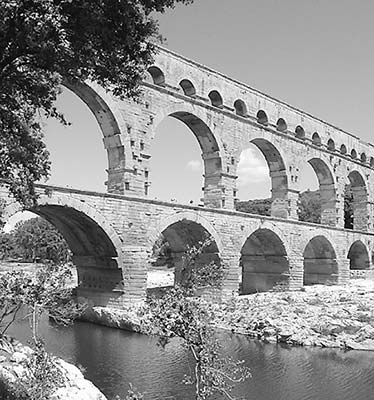
This was the biggest bridge in the whole 30-mile-long aqueduct. The arches are twice the width of standard aqueducts, and the main arch is the largest the Romans ever built—80 feet across (the width of the river). The bridge is about 160 feet high and was originally about 1,200 feet long.
Though the distance from the source (in Uzès, on the museum side of the site) to Nîmes was only 12 miles as the eagle flew, engineers chose the most economical route, winding and zigzagging 30 miles. The water made the trip in 24 hours with a drop of only 40 feet. Ninety percent of the aqueduct is on or under the ground, but a few river canyons like this required bridges. A stone lid hides a four-foot-wide, six-foot-tall chamber lined with waterproof mortar that carried the stream for more than 400 years. For 150 years, this system provided Nîmes with good drinking water. Expert as the Romans were, they miscalculated the backup caused by a downstream corner, and had to add the thin extra layer you can see just under the lid to make the channel deeper.
The stones that jut out—giving the aqueduct a rough, unfinished appearance—supported the original scaffolding. The protuberances were left, rather than cut off, in anticipation of future repair needs. The lips under the arches supported wooden templates that allowed the stones in the round arches to rest on something until the all-important keystone was dropped into place. Each stone weighs from two to six tons. The structure stands with no mortar (except at the very top, where the water flowed)—taking full advantage of the innovative Roman arch, made strong by gravity.
Cross to the right bank for a closer look and the best views. Soon find steps leading up a short, steep trail (marked View Point/Bellevedere). Follow the short-but-rugged trail with the river to your right to several superb lookouts above the aqueduct.
Back on the museum side, steps lead up to the top of the Rive Gauche side of the aqueduct, where tours meet to enter the water channel. From here you can follow the canal path along a trail (marked with red-and-white horizontal lines) to find remains of the Roman canal (spur trails off this path lead to more panoramic views). Hikers can continue along the path, following the red-and-white markings that lead through a forest, after which you’ll come across more remains of the canal (much of which are covered by vegetation). There’s not much left to see because of medieval cannibalization—frugal builders couldn’t resist the precut stones as they constructed area churches. The path continues for about 15 miles, but there’s little reason to go farther.

The hilltop town of Les Baux crowns the rugged Alpilles (ahl-pee) mountains, evoking a tumultuous medieval history. Here, you can imagine the struggles of a strong community that lived a rough-and-tumble life—thankful more for their top-notch fortifications than for their dramatic views. It’s mobbed with tourists most of the day, but Les Baux rewards those who arrive by 9:00 or after 17:30. (Although the hilltop citadel’s entry closes at the end of the day, once you’re inside, you’re welcome to live out your medieval fantasies all night long, even with a picnic.) Sunsets are dramatic, the castle is brilliantly illuminated after dark, and nights in Les Baux are ghost town-peaceful.
By Car: Les Baux is a 20-minute drive from Arles. Follow signs for Avignon, then Les Baux. Drivers can combine Les Baux with St-Rémy (15 minutes away).
On arrival in Les Baux, drivers pay to park near the village or several blocks below. Parking is all metered and squirreled all around the site (first hour is free, €3-4/hour after that, half the meters accept coins). You can park a 15-minute walk away for free at the quarry-cave called Carrières de Lumières, but arrive early to land a spot (described later, under “Near Les Baux”).
By Bus: From Arles, Cartreize bus #57 runs to Les Baux (6/day, 35 minutes, runs daily July-Aug, early May-June and Sept Sat-Sun only, none in off-season; via Abbey of Montmajour, Fontvieille, and Le Paradou; destination: St-Rémy, timetables at www.lepilote.com).
From Avignon, ride Cartreize bus #57 to St-Rémy (12/day Mon-Fri, 6/day Sat-Sun, 45 minutes), then continue to Les Baux on the same bus (described above). Otherwise, continue to Les Baux by taxi.
By Taxi: If buses aren’t running to Les Baux, you can taxi there from St-Rémy, then take another taxi to return to St-Rémy or to your home base. Figure €35 for a taxi one-way to Les Baux from Arles, €60 from Avignon, and €20 from St-Rémy (mobile 06 13 07 55 00).
By Minivan Tour: The best option for many is a minivan tour, which can be both efficient and economical (easiest from Avignon; see here).